Doug Wilson's Blog, page 4
May 20, 2017
The Ballad of Mr. Cub and Leo the Lip

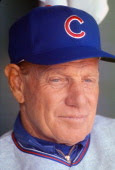
It was one of the most intriguing matchups in baseball history. Ernie Banks and Leo Durocher--thrown together in the same clubhouse. Rarely have two more disparate characters been coupled outside of a lousy television sitcom. Smiling Ernie Banks, the perpetually glass-is-half-full line drive of sunshine; a man so outrageously optimistic that he actually claimed the Cubs had a chance each spring when everyone else in the western hemisphere knew otherwise; but a man unable to lift his team out of mediocrity, no matter how brilliantly he played. Leo Durocher, the consummate tough-talking, rule-bending, angle-playing wise guy, who never hesitated to break any person in his way; a man summoned to Chicago to try to rescue a moribund franchise.
While Ernie was loved by millions and, except for a few ex-wives, liked by virtually everyone else, Leo was . . . well, I’m sure he must have once had a dog who acted like he liked him at dinner time.

Before he arrived in Chicago, Leo Durocher was already a baseball legend, an outsized caricature who dominated every scene by sheer force of personality. His baseball career had started with the Yankees of the late 1920s where as a hustling, under-talented shortstop, he famously had trouble getting along with Babe Ruth, who called him “the all-American out.” And he either did or did not steal the Babe’s watch, depending on whose version you're willing to believe. As a manager Leo had taken over losing teams in Brooklyn and New York and turned both into pennant winners.Possessing a voice with the commanding ring of a Marine drill sergeant and a snarl savage enough to give even the toughest of badasses pause, Leo could captivate a group of men like few others. Learning at an early age that yelling was the way for him to get the upper hand in life, he had an explosive temper that begged for anger management therapy.Durocher routinely used every vile invective and slur against both his players and opponents. Jews were Kikes, Italians were Dagos, and Blacks were, well, called much worse. And according to the grammatical rules Leo preferred, the slurs were most often used as adjectives, surrounded by other less-than-endearing terms, such as when he often referred to pitcher Ken Holtzman--to his face and in front of teammates--as a “gutless Kike bastard.”But it could not be accurately said that Leo was racist. He hated everyone equally--regardless of race, religion or belief--who stood between him and victory. He had taken a stand for Jackie Robinson during Jackie’s first spring with the Dodgers, telling a late-night meeting of the team, “I’ll play an elephant if he can do the job, and to make room for him I’ll send my own brother home.” With the Giants he had been a father figure to Willie Mays who adored him.Leo never lacked for enthusiasm, especially when there was a microphone in his face or a photographer nearby. While he loved publicity in general, he hated media members personally. For their part writers uniformly despised the man, but loved the fact that he was in their city; if nothing else, he was always good for easy copy.As a player and manager Leo Durocher was a master of the dark arts of baseball. Flinging dirt in infielders faces, kicking balls out of their gloves, stealing signs, beanballs, intimidation, nothing was too much if it helped him win a game. He would say virtually anything from the dugout to give his team an edge. When he yelled to his pitcher from the dugout, “Stick one in his ear,” no one doubted that he meant it with all his heart. No fan of sportsmanship, Leo said “Show me a good loser in professional sports, and I’ll show you an idiot.” And, “I believe in rules. Sure I do, if there weren’t any rules, how could you break them?” He wanted “scratching, diving, hungry ballplayers who come to kill you,” on his team. He freely admitted that if his mother was rounding third with the winning run he would trip her—but just to show that he did have a heart, he added that he would pick the old lady up and brush her off afterwards.
But few men could get more out of a team than Leo Durocher. While he knew baseball and knew how to win, he was extremely hard on his players. For those who won his approval, who showed their toughness through fire, they were his guys for life, or until the next loss. Only a certain type of ballplayer, with a certain tough hide, could play for Leo Durocher. His past was littered with the carcasses of players for whom he had no use; men he had broken. He loved letting his team know that no one’s job was secure, no matter the past. His favorite expression was to “back up the truck” as in loading up all the unwanted players and carting them away.Brutally frank and decisive, if Leo ever had a doubt about anything he did, he never showed it. Confidence exuded from his pores and enveloped him like a bad cologne. He was absolutely certain deep in his heart that there was no man whom he couldn’t bluff out of a pot while holding a hand full of nothing and there was no dame he couldn’t talk out of her pants with a few well-chosen words and a fist full of charm.
Although Leo had not managed a baseball team since 1955 he had remained very much in the public eye by coaching, commentating on televised games and being a general celebrity. He was perhaps the only man who could boast of achieving the 1960s cultural trifecta of appearing on the Mr. Ed, Munsters and Beverly Hillbillies television shows (as himself of course). When Fred Flintstone was wooed by a no-nonsense big league manager named Leo Ferocious of the Boulder City Giants, no one doubted who the cartoon character represented.

Ernie Banks was in many ways the polar opposite of Leo Durocher, exactly the kind of nice guy Leo famously said finished last. While Leo spent a lifetime refining how to get what he wanted by climbing in faces and forcing uncomfortable situations, Ernie was a walking conflict-avoidance seminar. He was constitutionally, almost pathologically, unable to have a forceful face-to-face disagreement with another human being. Want to know the essence of Ernie Banks: a 1967 clubhouse encounter with teammate Ron Santo tells you all you need to know. Santo played with Banks for more than a decade and knew him as well as anyone, which is to say he didn’t have a clue what made the man tick. When the hot-headed Santo entered the clubhouse the day after a tough loss and flew into a tirade, Ernie calmly pleaded, “Don’t let the past influence the present."
Santo turned on Banks and exploded, “What the hell’s wrong with you? You like losing?”
Ernie merely walked away while saying something about it being a lovely day—the fact that it was cloudy and drizzling at the time did not matter—and that it was time to “beat the Pirates, beat the Pirates.” That day, the Cubs did beat the Pirates, winning 8-4 and Ernie’s two doubles and Santo’s home run accounted for four RBIs.
Avoidance of conflict, avoidance of controversy, show the world only happy thoughts, put a positive spin on virtually everything; this was the protective hard-shelled candy coating in which Ernie Banks had successfully encased himself. It was a philosophy born of a combination of the optimism of Ernie’s Negro League manager, Buck O’Neil, and the ultraconservative don’t-ever-show-anybody-what-you-really-think and, above all, don’t-stand-out, Ernie’s father preached as a way to survive the uncompromising Jim Crow life of Dallas in the 1930s and 1940s.
It was a seemingly simple aura of smiling optimism and it worked well for Ernie. But was it the real Ernie Banks? We’ll never know, because he never told. Even those closest to him were never able to penetrate the candy coating. Few people, if any, ever knew the true Ernie Banks.

And where Leo loved talking to the media about himself, Ernie could not be forced to talk about himself by any means. Unfailingly polite with the media, he would hold forth at length spouting his well-worn clichés and meaningless optimistic proclamations and at the end of a half hour, the writer would have absolutely nothing. Even when young Ernie was copping consecutive MVP awards in the late ‘50s, writers approaching him for a personal story would come away with only, “Yessir, yessir, quite an honor to be included with these guys. That Willie Mays, what a great player. And, my, Henry Aaron. What a fantastic year he had.”
By the mid-1960s Ernie had perfected a smiling two-step whenever a writer got too close: “Thank you, thank you, it’s a beautiful day for baseball here at the friendly confines,” he would say while walking the writer to the other side of the clubhouse. “And the guys you want to talk to are right here, Donnie Kessinger and Glenn Beckert. Two of the next stars. The best young double play combo in baseball.” And when the writer turned around, Ernie would have vanished. It was a polished, seemingly effortless, shtick and always left Ernie looking like a good guy, while both giving young players some exposure and saving Ernie from any truly prying questions.
 By 1966 Ernie had been in Chicago a dozen years, the face of the franchise, not only a perennial All-Star but recognized as one of the game’s great gentlemen off the field. He never turned down a request for an autograph or a speaking engagement, often appearing gratis at Little League banquets and the like throughout the upper Midwest. He had a rare moral compass that refused to allow any public perception of trouble. Through all the losing years he never said a bad word about management. Ernie was the ultimate organization man for a team without organization. When he began to be referred to publicly as Mr. Cub in the early 1960s, no one disagreed. Banks had been one of baseball’s top hitters, hitting more home runs between 1955 and 1960 than anyone in the game. Although never out of shape, still retaining the thin frame that impossibly launched all those home runs, Ernie had not aged well. Chronic knee problems and a variety of other ailments had cut his production and forced a move from shortstop to first base in 1961. By 1966 Banks visibly hobbled at times on the field and in the dugout.
By 1966 Ernie had been in Chicago a dozen years, the face of the franchise, not only a perennial All-Star but recognized as one of the game’s great gentlemen off the field. He never turned down a request for an autograph or a speaking engagement, often appearing gratis at Little League banquets and the like throughout the upper Midwest. He had a rare moral compass that refused to allow any public perception of trouble. Through all the losing years he never said a bad word about management. Ernie was the ultimate organization man for a team without organization. When he began to be referred to publicly as Mr. Cub in the early 1960s, no one disagreed. Banks had been one of baseball’s top hitters, hitting more home runs between 1955 and 1960 than anyone in the game. Although never out of shape, still retaining the thin frame that impossibly launched all those home runs, Ernie had not aged well. Chronic knee problems and a variety of other ailments had cut his production and forced a move from shortstop to first base in 1961. By 1966 Banks visibly hobbled at times on the field and in the dugout.Leo Durocher, at 59, was still very much an energetic, dynamic, forceful, dominating personality when he was hired to manage the Cubs for the 1966 season. He was the alpha male of all he surveyed. Leo’s impact on the windy city was both immediate and seismic. The Cubs were fresh off four years of PK Wrigley’s ridiculous College of Coaches experiment and had not finished above 7th place since 1959. “I’m not a nice guy,” Leo said at his Chicago unveiling in October 1965. In case anyone was wondering, he added, “I’m still the same SOB I always was.”

“Pitching, defense and speed, that’s the kind of ball club I like,” pronounced Durocher that day. “And that’s what I’m going to be working toward with the Cubs. Hit and run, bunt, steal. You can’t win with those big slow-footed guys even if they do hit one out of the park for you once in a while.”Initially Durocher said, “As for Banks, he comes with the franchise and I’m glad to have him on my side for a change.” But anyone with even remote knowledge of the game could see that Leo obviously had other plans for the slow-footed first baseman who could no longer run, bunt or steal.
Shortly after taking over the Giants in 1949, as part of his master plan that would produce two pennants and a world championship within five years, Leo had traded thirty-something year old All-Stars Johnny Mize and Walker Cooper--less than two years removed from combining for 86 home runs—peddling them to open space on the team for the kind of guys he liked. He wanted to do something similar in Chicago and there was one big unavoidable target: Mr. Banks.
Durocher initially talked of trading Banks to the Giants for Orlando Cepeda, but he quickly learned what every other manager, director of player personnel and general manager (whatever Wrigley’s title de jour for them was) had learned: the chances of PK Wrigley agreeing to any trade involving Ernie Banks depended entirely on the weather—just in case Hell did freeze over . . .
Since Leo could not trade Ernie, he did the next best thing: he began to hate him and plotted a way to shame him off the field. Leo was merciless in pointing out Banks’ deficiencies to both Ernie and anyone who would listen. He constantly harped on Ernie’s lack of speed and publicly called him a “rally killer.”
“Mr. Cub, my ass,” he told reporters. “I’ll give Mr. Cub $100 anytime he even attempts to steal second.”[editors note: for the record Ernie Banks stole 4 bases in 7 attempts in the 6 seasons he played for Leo; it was never noted if Leo actually ponied up the $700].
Pitcher Fergie Jenkins later wrote, “One thing that drove Durocher nuts was that, at that point in Ernie’s career, when he was 35 or 36 years old, you didn’t have to be Einstein to know he wasn’t going to steal any bases. So Ernie took tiny leads off first base, like three inches. He wasn’t going to steal, and he sure as heck wasn’t going to let himself get picked off. Durocher screamed to the first-base coach, ‘Get him off! Get him off!’ Meaning he wanted him to make Ernie take a bigger lead so if someone got a hit he might make it to third base safely. That went on the whole year. The rest of us, sitting on the bench, watching and listening, just wanted to turn to Leo and say, ‘Give it a rest.’ But nobody did that. Ernie was just the greatest guy. He was a lot of fun to be with. He always talked when he was in the field. He was always bubbly and great to be around. Durocher seemed to be the only person on planet Earth who had trouble getting along with Ernie Banks.”
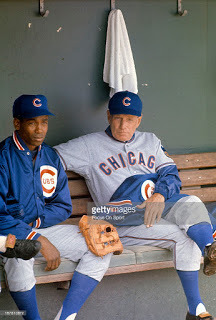
In Leo’s defense, inheriting an aging star is one of the least pleasant tasks for a new manager—a political and managerial quicksand for any polite leader concerned with social etiquette (see Stengel/DiMaggio). And Leo was never accused of politeness or social etiquette.
Also Leo loved to play amateur psychologist. No one had ever gotten on Banks before. Leo was making a statement to the entire team that no one was above reproach.
Others have hinted at more sinister motives: “He disliked Ernie from the go,” wrote longtime Cubs announcer Jack Brickhouse, himself no great Durocher fan. “It was just that Ernie was too big a name in Chicago to suit Durocher.”
While Leo grudgingly conceded that Ernie Banks had been a great player in his time,“Unfortunately, his time wasn’t my time,” he later wrote. “He couldn’t run, he couldn’t field; toward the end, he couldn’t even hit. . . . As a player, by the time I got there, there was nothing wrong with Ernie that two new knees wouldn’t have cured. He’d come up with men on the bases and if he hit a ground ball they could walk through the double play. . . . I’ve got to have somebody there who can play. Balls are going by there this far that should be outs or double plays. . . But I had to play him. Had to play the man or there would have been a revolution in the street. Ernie Banks owns Chicago.”
Leo was mystified at the goodwill Ernie had built up in the city and did not buy into his act. “How does he do it? You could say about Ernie that he never remembered a sign or forgot a newspaperman’s name. All he knew was, ‘Ho, let’s go. Ho, babydoobedoobedoo. It’s a wonderful day for a game in Chicago. Let’s play twooo.’ We’d get on the bus and he’d sit across from the writers. ‘A beaooootiful day for twoooo.’ It could be snowing outside, ‘Let’s play three.’”
Whatever the motive, the opportunity Leo hoped for arrived soon. In mid-May, 1966, with Banks hitting .188, the Cubs traded pitcher Ted Abernathy to the Braves for first baseman-outfielder Lee Thomas. “I’m going to him [Thomas] every chance to play regularly at first base,” Durocher announced to the press. “Ernie Banks hasn’t done it for me, so I’m going to give Lee every chance to show me.”Durocher made the peculiar move of shuffling Ron Santo to shortstop and putting Ernie at third base and Thomas at first—an ill-conceived experiment that weakened all three positions and lasted a mere four days. Then he benched Ernie and gave first base to Thomas outright.
But Thomas failed to cooperate with Leo’s plan. In early June, with Thomas hitting .200, Ernie was back as the regular first baseman and he launched an 8-game hitting streak. June 11, the old man legged out three triples in a game—all pokes to right field. But the slump returned. In early July Durocher announced that Banks was benched again—this time for powerful youngster John Boccabella, who had hit 30 homers in the minors in 1965. With the Cubs locked in the cellar, Durocher added, “The future of this team has to be with the young fellows.” The unmistakable message was that Banks was officially over the hill and finished.
Reporters wrote that Banks took the news with “Impeccably good grace. He has the unfailing gift of always saying the right thing.” Among the “right things” they quoted Ernie with saying was, “There comes a time in every player’s life when he must face up to this sort of thing. As we get older, we have to make way for the younger players. . . . I won’t say it doesn’t hurt because it definitely does. However, I simply have to adjust to it.”
But Boccabella failed to hit and once again, before the last shovel-full of dirt could be tossed on his grave, Ernie came back. From the All-Star game to August 11, over a five-week period, he hit .359 (37-103). He ended the season with a mediocre 15 homers, 75 RBIs and a .272 batting average for the last place, 59-103 Cubs.
All winter Leo said he was sticking with the youth movement, adding that Boccobella would be given a full shot at first. At one ceremony, Leo called Banks “Grandpa.” Liking the way it sounded, Leo used the term liberally throughout the winter.
And the offseason gave Leo time to think of a new strategy to deal with his unwanted aging star. February 28, 1967, Leo announced that Ernie Banks had been named to the Cubs’ coaching staff: “Banks will do a lot of playing for us, the only difference is that Ernie now will be able to teach our kids. He’ll have as much authority as any of the other four coaches.”
The move was a complete surprise, and Banks seemed more surprised than anyone else. It immediately led to open speculation and interpretation: was it was the beginning of the climb up the corporate ladder for Banks or was it a public relations move by Durocher to keep Banks on the bench. Durocher, sensing everyone’s suspicion, stated that this shouldn’t be construed in any way as a move to end Banks’ playing career. He added that Ernie still had a chance to fight off Boccabella for first base playing time. The tone left little doubt that the job appeared to be Boccabella’s to lose. For his part, Ernie smiled, noted that he would become just the fourth African-American major league coach (behind Buck O’Neil, Gene Baker and Junior Gilliam) and said, “It’s all very gratifying.”
Leo played Boccabella, Clarence Jones, Norm Gigon and Lee Thomas at first all through the spring, along with feeding rumors of other first base candidates being brought in by trades. Banks didn’t get any regular playing time until about 10 days before the exhibition season was over even as the mythical coaching duties never seemed to materialize.
While Ernie hit ropes in the batting cage, Leo acted like he didn’t notice, raving instead about the young prospects. When writers ventured that Banks was being ignored, Leo snarled, “Why don’t you knock off that Mr. Cub stuff? The guy’s wearing out. He can’t go on forever.”
It became a running gag in the press box, whenever Banks hit a home run or knocked in a key run: “Do you think Durocher will acknowledge that?”
Despite the near daily criticism and indications that he was through, outwardly Banks seemed exactly the same to observers. He never let on that it was anything other than another routine, glorious spring training in the sun. He showed up every day with a smile on his face, singing to pregame music, welcoming one and all to the park and cheering opposing teams through their calisthenics. Then he would get into the cage and flick line drives with his still-magnificent wrists.
Near the end of the spring, when Ernie was hitting .419, Leo conceded that the first base job probably belonged to him. Except for two second games of doubleheaders, Leo wrote “Banks” on the lineup card every game from April 28 to June 20. Ernie got off to his best first half since the MVP season of 1959 and made the All-Star team.
Leo Durocher delivered for the Cubs the way he had promised. Two decades of futility were laid to rest as the Cubs took over first place in July, 1967 for the first time since 1945. They finished the season in third place—their first time in the first division in 21 years. Ernie played in 151 games in 1967, finishing with 23 homers and 94 RBIs, second on the team to Santo’s 98 and second among league first basemen.
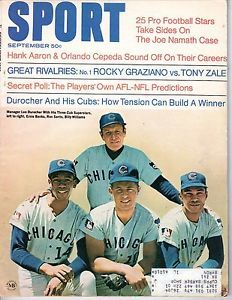 Reporters, eager for a good winter-time story, kept giving Banks chances to rub his success in Leo’s face, unmistakably teeing up leading questions. But Ernie steadfastly left the bat on his shoulder. In fact, in an act similar to happily digging through a pile of manure looking for a horse, he gave Leo credit for the good season. All that time on the bench in the spring, Ernie explained with a smile, had been the plan all along to allow him to get ready on his own, to take his time getting in shape. “That undoubtedly was a good break for me, because if I had tried to compete with the young fellows, I would have been struggling, really struggling. . . . [when the time to play came] I was ready.”It was an explanation Ernie repeated numerous times all through the fall and winter, leaving incredulous writers to question their sanity.
Reporters, eager for a good winter-time story, kept giving Banks chances to rub his success in Leo’s face, unmistakably teeing up leading questions. But Ernie steadfastly left the bat on his shoulder. In fact, in an act similar to happily digging through a pile of manure looking for a horse, he gave Leo credit for the good season. All that time on the bench in the spring, Ernie explained with a smile, had been the plan all along to allow him to get ready on his own, to take his time getting in shape. “That undoubtedly was a good break for me, because if I had tried to compete with the young fellows, I would have been struggling, really struggling. . . . [when the time to play came] I was ready.”It was an explanation Ernie repeated numerous times all through the fall and winter, leaving incredulous writers to question their sanity.The pattern quieted the next two years as Ernie got off to hot starts and showed that, while he couldn’t run, he could still drive in teammates. In the notoriously tough pitcher’s year of 1968, Ernie was second in the league with 32 home runs and his hot hitting helped the Cubs jump out to a big lead in 1969 as he ended up with 106 RBIs.
By 1970, however, Ernie’s body was just about ready for the glue factory. His knees were so swollen and achy that some days he could barely walk. The final countdown is difficult with any aged star and Ernie’s was no less painful, for him or his manager. Their relationship deteriorated as a familiar pattern played out: Leo would watch Ernie limping through the clubhouse and ask the trainer who would tell him that Ernie couldn't play and Leo would write him out of the lineup. Reporters would go to Ernie and he would say he felt fine. They would ask him why he didn’t play and Ernie would shrug and say, "The man says I play, I play.” They would then write that Durocher had benched Banks for no reason and fans would complain. Durocher felt that Ernie was betraying him with passive-aggressive behavior.
May 4, 1971 against the Mets, Ernie suffered the indignity all geriatric stars eventually face: he was removed for a pinch-hitter in a clutch situation. Teammates felt Leo humiliated Banks by allowing him to face Nolan Ryan three times, only to pinch-hit for him with right-handed batter Jim Hickman when lefty Ray Sadecki was on the mound in the eighth inning with men on first and third, trailing 2-1 . Ernie was in the ondeck circle when he unexpectedly saw the shadow of Hickman approaching. Hickman sheepishly told him, “I gotta hit for you.” Banks nodded without emotion, walked back, put his bat in the rack slowly and sat down on the bench—right next to Leo. He never said a word.
“Hickman told me later it was one of the toughest things he ever had to do,” wrote Brickhouse.
Ernie retired as a player after the 1971 season, but owner Wrigley kept him on the Cubs as a coach for 1972, against Leo’s wishes. By that time the Cubs’ pennant chances were in sharp decline. As the team struggled, amid speculation that Leo would be replaced, tempers flared, leading to a famous clubhouse explosion involving Leo, Milt Pappas, Joe Pepitone and Ron Santo. Afterwards Leo stormed out and threatened to quit. Ernie and coach Joey Amalfitano went to his office and tried to talk Durocher into staying. According to Durocher, Ernie told him, “Please Leo, don’t quit. We want you here. We need you. Don’t go doing something you might regret.”
Soon after, on September 3, PK Wrigley ran a full page ad in a Chicago paper backing Durocher. He concluded with the immortal line: “P.S. If only we could find more team players like Ernie Banks.”
Within two years Leo and Ernie were both gone from the Cubs clubhouse.
It is insightful to look at their words in the years after their time together. They both stayed remarkably true to character. Ernie never said a bad word about Leo and Leo, well, they didn’t call him Leo the Lip because of his trumpet-playing ability.Over the next four decades numerous interviewers gave Ernie a chance to trash Leo. Or at least take a few good pokes. He never did. Usually he changed the subject or offered only bland statements. Ernie knew exactly what everyone else said and thought, but he pretended not to. When cornered, he only gave them: “I learned long ago that when you say derogatory things about people it stays with you. Everybody remembers it, especially if it’s written. You can’t retract those things. Of course you have those feelings. . . . but suppose that tomorrow you feel he’s a nice guy again."
In Banks’ 1971 autobiography the chapter dealing with the late ‘60s was titled, “Life With Leo.” While the title of the chapter may have given readers hope of learning his true thoughts, in keeping with the entirely vanilla tone of the book, there were exactly zero negative comments. Ernie credited “Leo’s leadership” with helping the Cubs become a winner. “Leo is unlike any other manager I’ve played for,” he stated. But he offered no specifics. Instead there were generic statements such as “A bark now, a good laugh a little later. He does it to keep us on our toes,” and “Leo can build a players’ morale like no one else.” He credited “Leo’s fine head planning and plotting for the future.” There was absolutely nothing about what “Life with Leo” was really like.
In 1977 Jet magazine offered an article with the leading title, “Banks Finally Tells of Durocher’s Many Insults.” Actually in the article, Banks told very little. The article summed up the many insults and included quotes from others, but Banks himself said nothing of substance.
In his old age, Ernie would add his own altered reality: “It was misinterpreted that Leo disliked me. He made my life better, he made me a better player,”and “Leo wasn’t jealous of me. I think he was just trying to push me. You know, when you’re in the latter stages of a career like I was, sometimes you get lackadaisical. I understood what he was trying to do.”
In 2006, the 71-year-old Banks finally allowed that life with Leo was a bit tough. Even then he quickly added, “As hard as he [Durocher] was on me, I tried to treat him with kindness, always talked to him, on the lane, in the dugout.”
Of course, Leo was much less reserved, and much more nasty. In his book “Nice Guys Finish Last” he devoted an entire chapter to Ernie. It was not a nice chapter. He took care to tarnish both Ernie Banks the player and the myth. He even took swipes at Ernie’s book, writing “All the writers in the country rushed to write what a great book it was, and all of them said in private, ‘If he wanted to write a book, with all the goodwill he has going for him, why didn’t he get himself a writer?' I don’t know why it is, but where Ernie is concerned everybody is always ready to fall over and play dead.”[In Leo’s defense, the criticism of Ernie’s co-writer, Jim Enright, was entirely valid—and it takes only a reading a few pages to agree].
Years later, Leo Durocher had a change of heart, perhaps surgically induced. In 1983 a very contrite 78-year-old Leo, recovering from a recent open heart procedure, perhaps seeing his own mortality at last, spoke at a Cubs reunion and tearfully apologized to the team in general and Ernie Banks specifically for how he had behaved.
Leo passed away in 1991 at the age of 86, Ernie in 2015 at 84. It's nice to think that they are now finally happy together in a better place:
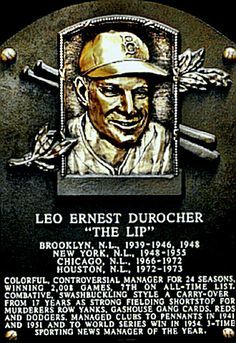
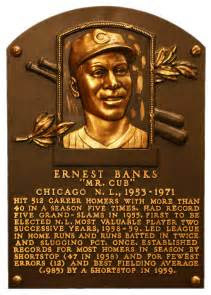
Published on May 20, 2017 07:05
February 20, 2017
When Johnny Bench's Career Almost Ended at 25
The Cincinnati Reds were only three outs away from being eliminated in the 1972 Playoffs. Trailing the defending World Champion Pittsburgh Pirates, 3-2, in the fifth and final game, Johnny Bench led off the bottom of the ninth inning against the Pirates' ace reliever Dave Guisti.
As Bench prepared to leave the on-deck circle, his mother caught his eye. Katy Bench had left her seat and worked her way to the rail near the Reds dugout. Although Katy would later tell a reporter that she yelled, "This is it," in the version Johnny would tell for years he heard her say, “Hit a home run." The exact words are perhaps unimportant, (who can hear clearly when 50,000 fans are screaming?) but his account sounded much better for the myth-makers.
The dutiful son then walked to home plate, swung at an outside two-strike pitch and lined it over the right field wall. Riverfront Stadium exploded. In the broadcasting booth, the voice of 28-year-old Reds announcer Al Michaels reached an octave previously thought unattainable by primates. Although the Reds didn’t officially win the game until a few minutes later when George Foster scored on a wild pitch, there was no doubt that the game was over as soon as Bench’s drive cleared the wall.
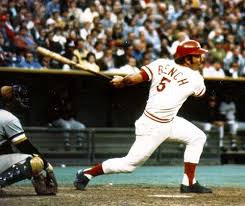
It would be remembered as the most dramatic moment in Reds’ history. And the amazing thing about it was that as Bench walked to the plate for that at bat, he was burdened with a secret. None of the fans, no one in the press box, very few in the dugout knew that if he had made an out here, if the Reds failed to advance to the World Series, there was a plausible chance that this would be the last at bat of his major league career.
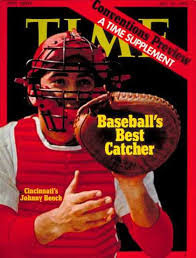
Johnny Bench had proven himself to be a once-in-a-generation transcendent talent. He hit 45 home runs and 148 RBIs in 1970 and followed that with 40 and 129 in 1972, leading the league in both categories both times. On defense, it was immediately apparent that Bench was special from the first day he laced up the shin guards in a late 1967 call-up. No one else would win a National League Gold Glove for catching for the next ten years.
By the end of the 1972 season, Bench had played in five All-Star games and had taken home five Gold Gloves and two MVP awards--and he hadn’t turned 25 yet.
In addition he had reached a level of pop-cultural appeal rarely seen among baseball players. He had toured with Bob Hope, appeared on the popular TV spy show Mission Impossible and belted out songs on Hee Haw. Few major league players would have even tried pulling off the act of snapping his fingers in front of Junior Samples and a hound dog, surrounded by hay bales and fake corn, wearing a pair of lime-green pants borrowed from Kermit the Frog. He was clearly a man of rare talents and accomplishments.
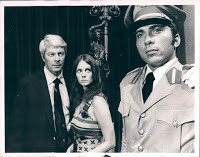
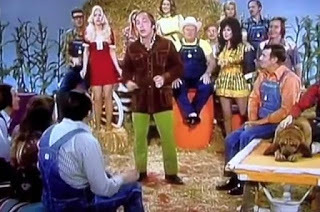
The trouble started when Reds players had their annual routine physical exams in early September. Traditionally this was a casual off-day away from the ballpark, a chance for Pete Rose and Joe Morgan to hold court trading endless put-downs and wise cracks, for Tony Perez to sneak among his teammates, pinching them on the butt and then scurrying away giggling. Few players took the tests seriously. The players, all marvelous athletic specimens in the prime of their lives, passed easily. All except one.
Johnny Bench got a call the next day from someone at the hospital who wanted him to return for another Chest X-Ray; the first one had been a bit blurry, he was told. So Bench went back the next day and the X-Ray was repeated. Before he could leave, they needed another one—just routine, he was told. Then they wanted to do some more tests. Finally he learned the problem: there was a spot on his right lung. A spot that hadn’t been there the previous year.

Doctors couldn’t tell exactly what the spot represented—it could be benign or it could be cancer; they needed more tests to be sure. Blood tests for the usual suspects, tuberculosis and histoplasmosis, were taken and came back negative. Attempts to reach the lesion with a bronchoscope were unsuccessful. Bench was informed that they would need a more invasive test to determine the diagnosis. The only other option was to just watch the lesion awhile and see if it changed. But if they waited and it turned out to be malignant, the waiting would throw away the only chance of cure.
In 1972 lung cancer was almost uniformly fatal. Immediately jumping to mind was the movie Brian’s Song which had debuted the previous year, making more tough he-men run for the kitchen to avoid public tears than anything since Old Yeller. Dying jocks were on the brain.
What Bench would need in order to diagnose the spot on his lung was a serious surgical procedure. The medical term thoracotomy was derived from old Greek which, loosely translated, means to have one’s chest filleted open like a mackerel. In 1972 technology the most-commonly used, traditional operation was a posterolateral thoracotomy in which the large muscles of the back, the latissimus dorsi, were completely cut through, often accompanied by the removal of a rib. It was, and remains, one of the most painful surgical incisions known, usually resulting in a slow agonizing recovery process. Cutting through and then sewing the muscles results in scar tissue which can restrict free arm movement. Playing baseball at a high level afterwards is an iffy prospect and could take as long as a year, or longer.

While digesting this information and what it might mean--for his career and his life--Bench silently bore the strain and went about his day job. He not only showed up for work, but performed brilliantly in the closing weeks of the season, hitting 11 home runs and 33 RBIs during the month of September as the Reds drove toward the pennant. Only closest family members and friends were told.
One of those let in on the secret, Bench's attorney and friend Reuven Katz, also happened to represent the surgical department of the University of Cincinnati Medical School. Katz made some discrete inquiries about thoracic surgery and came up with the name of Luis Gonzalez.
Luis Gonzalez, 45 years old in 1972, was a trim, dark-haired man with a warm smiling face and a good sense of humor. A war-time Marine before going to medical school, he had been on staff at the University of Cincinnati for a decade and was known not only as an excellent surgeon, but an innovator. Dr. Gonzalez had been an early proponent of a type of incision for these operations that avoided severing the latissimus dorsi and removing a rib.
Bench met with Dr. Gonzalez and a date was set for the surgery to take place in early December. A brief statement was released to the press informing them of the procedure before Bench entered the hospital, just days after his 25th birthday.
Suddenly Johnny Bench was the most famous hospital patient in the midwest. Cincinnati's two daily newspapers, along with those in nearby Dayton, would keep interested citizens informed of his progress with daily articles, in both the front page and sports page, for the next two weeks.

Modern baseball fans, accustomed to players having a myriad of off-season surgical procedures and returning unscathed the next season, should realize that in 1972, the type of operation Bench underwent, although termed a muscle-sparing procedure, was still a harrowing experience. The incision started just below his right nipple and arched under his armpit toward the back. A minor muscle, the serratus anterior, was severed to reach the chest wall.

Next, think of the meaty space between the ribs the last time you had a rack at your favorite barbecue joint. This muscle was cut through with a blade. The surgeon then reached for a sinister-looking torture device called a rib-spreader. The scariest aspect of the rib-spreader is that there is no attempt at deception--it does exactly what the name implies: it . . . spreads . . . ribs.
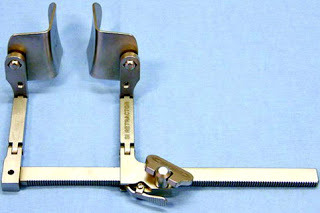
The metal ends are inserted between the ribs and the knob turned, gradually spreading, widening the ribs until adequate visualization of the contents of the chest is achieved. If done too forcefully, this could break ribs or dislocate them from their attachments. Also spreading the ribs stretches the nerve that runs just underneath, resulting in prolonged pain.
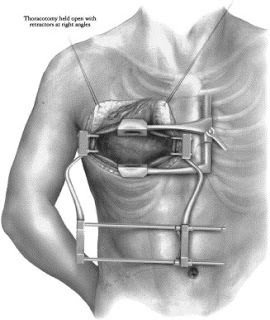
Once the biopsy was taken and bleeding controlled, the whole mess was closed with multiple layers of sutures, some in the muscles, some in the tissue beneath the skin and, last, the skin itself. Legend has it that the surgeon, a veteran of more than 15 years in the operating room, remarked that he had never seen a patient with such unusually developed musculature as Bench had in his back.
The operation took two hours and was a success. The lesion, which was slightly larger than a marble, was found in a fissure between the lower and upper lobes of the right lung and was completely removed along with a small amount of actual lung tissue. A frozen section pathology exam was done during the procedure and revealed no sign of cancer.
The official diagnosis, confirmed with further tests in the lab, was coccidiodomycosis, a fungus which is ubiquitous in the southwest. Infection occurs by breathing in an airborne spore which then causes an inflammatory lesion in the lung. It was felt that Bench had probably contracted it in during a golf tournament in the southwest the preceding year.
The patient made a quick recovery. Two days after the operation, dressed in red pajamas and a pink robe, Johnny held a press conference in his hospital room. He proudly showed off the gnarly ten-inch scar and joked with reporters that he was taking interviews for pretty young nurses to look after him when he went home. He added that he hoped to be able to use the operation as an excuse in spring training. “If Sparky Anderson gets tough I can just say, ‘Hey, Sparky, I’ve got this lung, you know.’”
Bench spent a restless six weeks recovering. By early February, he was testing his baseball swing and playing golf. By spring training, he was ready. He would catch every game during the exhibition season, a marked increase to his normal spring work load.
Early, there were rumors that his famed right arm was not yet back to strength. In one of the first spring games, two successive Cardinal base runners tried him out and both would-be thieves were gunned down at second. By the time the season started, the rest of the league had regained their healthy respect for Bench's wing. While the 1973 Reds were stealing 148 bases, only 55 brave souls dared to attempt to take a base without permission against Bench. Half were thrown out.
Bench started slowly at the plate, but in early May he had put together a modest nine-game hitting streak when the Reds traveled to Philadelphia to face the Phillies and their ace Steve Carlton. Bench then treated the Hall of Fame-bound Carlton like a batting practice pitcher, slamming three home runs and seven RBIs in a 9-7 win—he was back. Oddly, it was the second time in three years Bench had victimized Lefty with a three-homer game.
To a casual observer, Bench seemed to bear little negative effect from the drama of the offseason. He would play in 152 games (134 as catcher) in 1973 and finish the season with 104 RBIs. He went on to play ten more years, retiring as the all-time leader in home runs and RBIs for a catcher and had more RBIs than any major league player for the decade of the 1970s.
But the operation did have a cost. While remaining a good RBI man, Bench was not the power-hitter he had been. In the three seasons before the operation, he had averaged 37 home runs a year. His best seasons afterwards were 33 home runs in 1974 and 31 in 1977. He later admitted that he was never quite the same player. “I never felt like I was Johnny Bench after that surgery.”
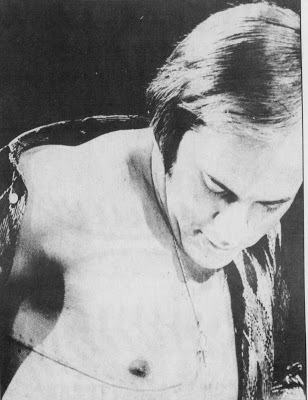
All things considered, it's remarkable he was able to perform as well as he did. And it's awe-inspiring to wonder what might have been, considering his first five seasons.
As Bench prepared to leave the on-deck circle, his mother caught his eye. Katy Bench had left her seat and worked her way to the rail near the Reds dugout. Although Katy would later tell a reporter that she yelled, "This is it," in the version Johnny would tell for years he heard her say, “Hit a home run." The exact words are perhaps unimportant, (who can hear clearly when 50,000 fans are screaming?) but his account sounded much better for the myth-makers.
The dutiful son then walked to home plate, swung at an outside two-strike pitch and lined it over the right field wall. Riverfront Stadium exploded. In the broadcasting booth, the voice of 28-year-old Reds announcer Al Michaels reached an octave previously thought unattainable by primates. Although the Reds didn’t officially win the game until a few minutes later when George Foster scored on a wild pitch, there was no doubt that the game was over as soon as Bench’s drive cleared the wall.

It would be remembered as the most dramatic moment in Reds’ history. And the amazing thing about it was that as Bench walked to the plate for that at bat, he was burdened with a secret. None of the fans, no one in the press box, very few in the dugout knew that if he had made an out here, if the Reds failed to advance to the World Series, there was a plausible chance that this would be the last at bat of his major league career.

Johnny Bench had proven himself to be a once-in-a-generation transcendent talent. He hit 45 home runs and 148 RBIs in 1970 and followed that with 40 and 129 in 1972, leading the league in both categories both times. On defense, it was immediately apparent that Bench was special from the first day he laced up the shin guards in a late 1967 call-up. No one else would win a National League Gold Glove for catching for the next ten years.
By the end of the 1972 season, Bench had played in five All-Star games and had taken home five Gold Gloves and two MVP awards--and he hadn’t turned 25 yet.
In addition he had reached a level of pop-cultural appeal rarely seen among baseball players. He had toured with Bob Hope, appeared on the popular TV spy show Mission Impossible and belted out songs on Hee Haw. Few major league players would have even tried pulling off the act of snapping his fingers in front of Junior Samples and a hound dog, surrounded by hay bales and fake corn, wearing a pair of lime-green pants borrowed from Kermit the Frog. He was clearly a man of rare talents and accomplishments.


The trouble started when Reds players had their annual routine physical exams in early September. Traditionally this was a casual off-day away from the ballpark, a chance for Pete Rose and Joe Morgan to hold court trading endless put-downs and wise cracks, for Tony Perez to sneak among his teammates, pinching them on the butt and then scurrying away giggling. Few players took the tests seriously. The players, all marvelous athletic specimens in the prime of their lives, passed easily. All except one.
Johnny Bench got a call the next day from someone at the hospital who wanted him to return for another Chest X-Ray; the first one had been a bit blurry, he was told. So Bench went back the next day and the X-Ray was repeated. Before he could leave, they needed another one—just routine, he was told. Then they wanted to do some more tests. Finally he learned the problem: there was a spot on his right lung. A spot that hadn’t been there the previous year.

Doctors couldn’t tell exactly what the spot represented—it could be benign or it could be cancer; they needed more tests to be sure. Blood tests for the usual suspects, tuberculosis and histoplasmosis, were taken and came back negative. Attempts to reach the lesion with a bronchoscope were unsuccessful. Bench was informed that they would need a more invasive test to determine the diagnosis. The only other option was to just watch the lesion awhile and see if it changed. But if they waited and it turned out to be malignant, the waiting would throw away the only chance of cure.
In 1972 lung cancer was almost uniformly fatal. Immediately jumping to mind was the movie Brian’s Song which had debuted the previous year, making more tough he-men run for the kitchen to avoid public tears than anything since Old Yeller. Dying jocks were on the brain.
What Bench would need in order to diagnose the spot on his lung was a serious surgical procedure. The medical term thoracotomy was derived from old Greek which, loosely translated, means to have one’s chest filleted open like a mackerel. In 1972 technology the most-commonly used, traditional operation was a posterolateral thoracotomy in which the large muscles of the back, the latissimus dorsi, were completely cut through, often accompanied by the removal of a rib. It was, and remains, one of the most painful surgical incisions known, usually resulting in a slow agonizing recovery process. Cutting through and then sewing the muscles results in scar tissue which can restrict free arm movement. Playing baseball at a high level afterwards is an iffy prospect and could take as long as a year, or longer.

While digesting this information and what it might mean--for his career and his life--Bench silently bore the strain and went about his day job. He not only showed up for work, but performed brilliantly in the closing weeks of the season, hitting 11 home runs and 33 RBIs during the month of September as the Reds drove toward the pennant. Only closest family members and friends were told.
One of those let in on the secret, Bench's attorney and friend Reuven Katz, also happened to represent the surgical department of the University of Cincinnati Medical School. Katz made some discrete inquiries about thoracic surgery and came up with the name of Luis Gonzalez.
Luis Gonzalez, 45 years old in 1972, was a trim, dark-haired man with a warm smiling face and a good sense of humor. A war-time Marine before going to medical school, he had been on staff at the University of Cincinnati for a decade and was known not only as an excellent surgeon, but an innovator. Dr. Gonzalez had been an early proponent of a type of incision for these operations that avoided severing the latissimus dorsi and removing a rib.
Bench met with Dr. Gonzalez and a date was set for the surgery to take place in early December. A brief statement was released to the press informing them of the procedure before Bench entered the hospital, just days after his 25th birthday.
Suddenly Johnny Bench was the most famous hospital patient in the midwest. Cincinnati's two daily newspapers, along with those in nearby Dayton, would keep interested citizens informed of his progress with daily articles, in both the front page and sports page, for the next two weeks.

Modern baseball fans, accustomed to players having a myriad of off-season surgical procedures and returning unscathed the next season, should realize that in 1972, the type of operation Bench underwent, although termed a muscle-sparing procedure, was still a harrowing experience. The incision started just below his right nipple and arched under his armpit toward the back. A minor muscle, the serratus anterior, was severed to reach the chest wall.

Next, think of the meaty space between the ribs the last time you had a rack at your favorite barbecue joint. This muscle was cut through with a blade. The surgeon then reached for a sinister-looking torture device called a rib-spreader. The scariest aspect of the rib-spreader is that there is no attempt at deception--it does exactly what the name implies: it . . . spreads . . . ribs.

The metal ends are inserted between the ribs and the knob turned, gradually spreading, widening the ribs until adequate visualization of the contents of the chest is achieved. If done too forcefully, this could break ribs or dislocate them from their attachments. Also spreading the ribs stretches the nerve that runs just underneath, resulting in prolonged pain.

Once the biopsy was taken and bleeding controlled, the whole mess was closed with multiple layers of sutures, some in the muscles, some in the tissue beneath the skin and, last, the skin itself. Legend has it that the surgeon, a veteran of more than 15 years in the operating room, remarked that he had never seen a patient with such unusually developed musculature as Bench had in his back.
The operation took two hours and was a success. The lesion, which was slightly larger than a marble, was found in a fissure between the lower and upper lobes of the right lung and was completely removed along with a small amount of actual lung tissue. A frozen section pathology exam was done during the procedure and revealed no sign of cancer.
The official diagnosis, confirmed with further tests in the lab, was coccidiodomycosis, a fungus which is ubiquitous in the southwest. Infection occurs by breathing in an airborne spore which then causes an inflammatory lesion in the lung. It was felt that Bench had probably contracted it in during a golf tournament in the southwest the preceding year.
The patient made a quick recovery. Two days after the operation, dressed in red pajamas and a pink robe, Johnny held a press conference in his hospital room. He proudly showed off the gnarly ten-inch scar and joked with reporters that he was taking interviews for pretty young nurses to look after him when he went home. He added that he hoped to be able to use the operation as an excuse in spring training. “If Sparky Anderson gets tough I can just say, ‘Hey, Sparky, I’ve got this lung, you know.’”
Bench spent a restless six weeks recovering. By early February, he was testing his baseball swing and playing golf. By spring training, he was ready. He would catch every game during the exhibition season, a marked increase to his normal spring work load.
Early, there were rumors that his famed right arm was not yet back to strength. In one of the first spring games, two successive Cardinal base runners tried him out and both would-be thieves were gunned down at second. By the time the season started, the rest of the league had regained their healthy respect for Bench's wing. While the 1973 Reds were stealing 148 bases, only 55 brave souls dared to attempt to take a base without permission against Bench. Half were thrown out.
Bench started slowly at the plate, but in early May he had put together a modest nine-game hitting streak when the Reds traveled to Philadelphia to face the Phillies and their ace Steve Carlton. Bench then treated the Hall of Fame-bound Carlton like a batting practice pitcher, slamming three home runs and seven RBIs in a 9-7 win—he was back. Oddly, it was the second time in three years Bench had victimized Lefty with a three-homer game.
To a casual observer, Bench seemed to bear little negative effect from the drama of the offseason. He would play in 152 games (134 as catcher) in 1973 and finish the season with 104 RBIs. He went on to play ten more years, retiring as the all-time leader in home runs and RBIs for a catcher and had more RBIs than any major league player for the decade of the 1970s.
But the operation did have a cost. While remaining a good RBI man, Bench was not the power-hitter he had been. In the three seasons before the operation, he had averaged 37 home runs a year. His best seasons afterwards were 33 home runs in 1974 and 31 in 1977. He later admitted that he was never quite the same player. “I never felt like I was Johnny Bench after that surgery.”

All things considered, it's remarkable he was able to perform as well as he did. And it's awe-inspiring to wonder what might have been, considering his first five seasons.
Published on February 20, 2017 11:10
February 9, 2017
Say it Wasn't So: Joe Jackson, World War I's Most Famous Baseball Slacker
Here's one you may not have heard: how Shoeless Joe Jackson was almost turned into America's most-hated draft-dodger in World War 1. It's true, but as with all Shoeless Joe stories, some work is required to separate fact from myth. It also helps to read published reports from his contemporaries and to view everything in the context of the times and to be aware of other forces which were at work.
The War began in Europe in July, 1914 but had little effect on baseball in America the first few years. The 1916 season had been both successful on the field and profitable for the owners. Business was good. But things would soon be changing. The United States declared war on Germany just days before the start of the 1917 season.
Initially there was talk of shutting down baseball--a thought that mortified owners, who understandably did not want to lose their businesses. White Sox owner Charles Comiskey was especially unhappy at the prospect. He had invested heavily to build his championship-caliber team (he spent his money on obtaining players, not necessarily on paying them). His star hitter, Joe Jackson, had been acquired from Cleveland in 1915 in a deal described as worth $74,000--$31,000 in cash and 3 players who had cost Comiskey $44,000--one of the most expensive deals of the time.
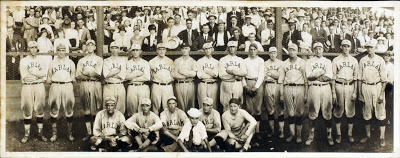
Outwardly eager to help the national cause, baseball owners made a great show of their patriotism. They donated cash and rounded up baseball equipment for soldiers to use in their spare time. Exhibition baseball games were played for the benefit of the Red Cross. Special enlistment booths were set up at American League parks. Players went through military marching drills in pre-game ceremonies. There was even a prize for the best drilling major league team.
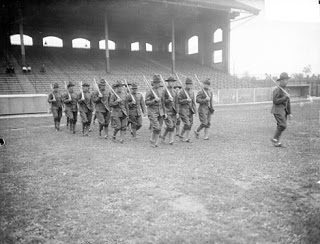
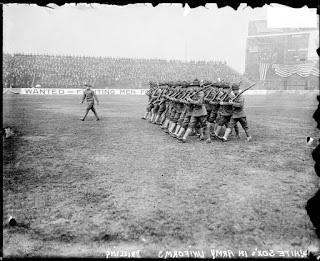
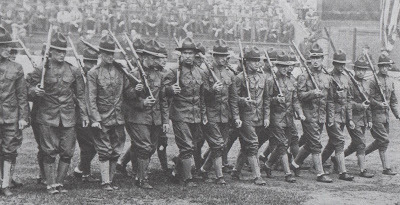
The Chicago White Sox go through pregame military drills (Jackson is third from the right)
As the war turned into a second year, the owners agreed to abbreviate the 1918 schedule to 140 games. It soon became obvious that benefits and drills and shortened seasons were not going to be enough to keep baseball players out of the war, however. When the U.S. military leaders got their first real good look at the teeth of the German military machine, they murmured around their cigarettes, "We're gonna need a bigger army."
And thus in May, 1918 Provost Marshall General Enoch Crowder issued the famous "Work or Fight" order, stating that every healthy male between the ages of 21 and 30 must find "essential work" by July 1 or face military conscription.
The wording of the order was particularly chilling for baseball owners. It included a list of employment which was regarded as nonessential to the war effort: "games, sports and amusements, excepting actual performers in legitimate concerts, operas or theatrical performances." Baseball owners were suddenly aware that they needed to round up some guys who could not only hit .300 and play the field, but do so while wearing a Viking helmet and belting out a rousing falsetto. But since such men were in short supply at the time (they always seem to be), other arrangements needed to be made.
Initially owners tried to get special consideration for their able-bodied players. While the government in Washington indicated that they hoped the game would go on, if it could be accomplished "in harmony with the great purpose of putting winning the war first above everything," and Crowder released another statement within a week suggesting that ballplayers would be considered by draft boards on an individual basis, it became clear that a great many ballplayers would be leaving their teams. Overall, an average of 15 players would be lost per team in the 1918 season.
Which brings us to Joe Jackson. In 1918 Joe was 30 years old and had completed seven major league seasons with a sparkling .352 lifetime batting average. He was considered to be the second best hitter in the land (some thought the best at purely swinging the stick as Ty Cobb usually bunted enough to get more than the five or so hits per 500 at bats that gave him the roughly ten point lead in average, whereas Joe bunted about as often as he read from The Complete Works of William Shakespeare).
In 1917 Joe had hit .301, the worst average of his career, but he had helped to lead the White Sox to the World Series title (he hit .304 in the Series, not bad, but not as good as the .375 he would hit in the more famous Series two years later).
As a great hitter and key member of the World Champs, Jackson was one of the game's most famous personalities. But he was also one of the most difficult for fans and writers to figure out. His very existence seemed to be an amalgam of assorted tall-tales, half-truths and outright lies. Joe himself did little to clear up the confusion when interviewed or spotted on the street.
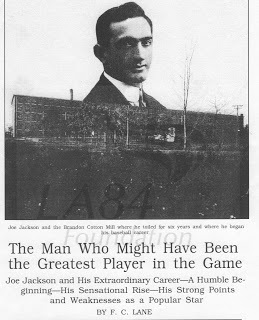 In a 1916 profile for Baseball Magazine, one of the pre-eminent early baseball writers, F. C. Lane, reported that "The oddest character in baseball today is that brilliant but eccentric genius, Joe Jackson. . . To sum up his talents is merely to describe those qualities which should round out and complete the ideal player. In Jackson, nature combined the greatest gifts any one ball player has ever possessed but she denied him the heritage of early advantages and that well balanced judgement so essential to the full development of his extraordinary powers." And that lack of early advantages and well-balanced judgement would prove to be very important to Joe in the years to come.
In a 1916 profile for Baseball Magazine, one of the pre-eminent early baseball writers, F. C. Lane, reported that "The oddest character in baseball today is that brilliant but eccentric genius, Joe Jackson. . . To sum up his talents is merely to describe those qualities which should round out and complete the ideal player. In Jackson, nature combined the greatest gifts any one ball player has ever possessed but she denied him the heritage of early advantages and that well balanced judgement so essential to the full development of his extraordinary powers." And that lack of early advantages and well-balanced judgement would prove to be very important to Joe in the years to come.By the spring of 1918 three of Joe Jackson's brothers had already volunteered for military service. Joe was the sole supporter of his wife, Katie, his mother, a younger brother and a sister. Because of this, the Greenville, South Carolina draft board had placed him in Class 4, making him safe from the draft.
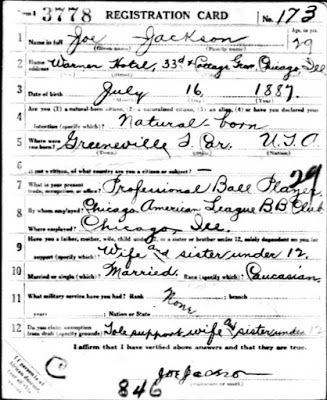
Joe Jackson's draft card (those under the impression that Jackson was unable to write should note the fairly legible signature at the bottom)
After 17 games of the 1918 season, Joe was hitting .354. The White Sox were in Philadelphia for a series against the A's when Joe received a dispatch informing him that the Greenville draft board had reclassified him 1-A. He reported as ordered to the Philadelphia examining board, passed with a perfect mark and was told to expect orders to leave for an army training camp within the next two weeks.
When the White Sox departed for Cleveland the next day, Joe Jackson was nowhere to be found. He soon turned up and announced that he had found a position of employment with the Harlan and Hollingsworth Shipbuilding Company, a subsidiary of Bethlehem Steel, in Wilmington, Delaware. Work in the shipbuilding industry was considered essential and thus exempted Joe from military service.
The news did not play well in the national press. While many other players were avoiding combat by playing on ball teams in industry and the military, Joe Jackson, the most prominent of the early names, was singled out.
That week's Sporting News carried several editorials about the "Jackson Case," as it was roundly being called. Readers were informed that "at a time of every man doing his patriotic duty," Joe Jackson was "cleverly seeking exemption when by all rights . . . he should be in an Army or Navy training camp." Jackson "owed it to the great game he represents, to join the military and set an example to myriads of youngsters coming of age who hold him as an example."
In the same issue, American League President Ban Johnson "leveled a solar plexus wallop at the baseball slacker." Johnson, who hated Charles Comiskey's ample guts and loved nothing more than a chance to knife his enemy when he was vulnerable, to publicly humiliate him, derail his business and maybe cost him a player or two, announced a warning to players seeking to avoid conscription. He told the writer he would like to yank back by the collar those who entered employment with the ship construction business particularly. Johnson left little doubt this was specifically in response to Joe Jackson's status. Johnson would soon announce that hereafter athletes would have to stick with their clubs until the final Government call, and then go straight to war-service.
That was only the beginning. A scathing editorial soon followed in the Chicago Tribune entitled "The Case of Joe Jackson." Joe, a man of "unusual physical development," who "presumably would make an excellent fighting man," was excoriated and branded a coward and shirker.
Another article entitled "Retreats to Shipyard" stated "The fighting blood of the Jacksons is not as red as it used to be in the days of old Stonewall and Old Hickory for General Joe of the White Sox has fled to the refuge of a shipyard."
Charles Comiskey, according to some sources, had initially encouraged his players to try to find exemptions to remain playing for the White Sox as long as possible. Always careful of the winds of public opinion, however, he now pompously joined in piling on his employee. Comiskey was shocked (shocked!) that one of his beloved employees would even think of trying to avoid military service in this time of national need. "There is no room on my club for players who wish to evade the army draft by entering the employ of shipbuilders," he told reporters from atop his soapbox. The great man was so disappointed, he threatened to not take the "jumpers" back after the war. Skeptics to Comiskey's pure intentions would later point out that while this posture kept him on the side of patriotism and duty, it also prepared him for future player negotiations, well aware that a man who thinks he is not welcomed back (and has no other employment options due to the reserve clause) is much more pliable at the contract table.
It soon became apparent that the thing that truly rankled Comiskey was not that Joe Jackson was shirking his duty to his country by not carrying a rifle, but that he was doing so while playing baseball for someone else; and doing so while Comiskey's team was certain to fall in the standings.
According to Baseball Magazine, "One disagreeable feature made itself manifest during May--what looked almost like a second Federal League, fostered and developed under the wing of the Government . . . a new league of steel, shipbuilding, and munition plants, with the players mostly well-known stars of the present or the past. There was a gasp of surprise when the list of players gathered by the steel plants was given out. . . It was frankly asserted [by major league owners] that agents of the steel plants were gathering big league stars, promising them fat salaries, nominal positions in the plants, with nothing to do but play ball, and at the same time pointing out that munition workers wouldn't have to go to the trenches. . . . The pot boiled over, though, when Joe Jackson, the great star of the White Sox, after being called by the draft, announced that he would enter a shipbuilding or steel-plant and the steel-folks began to bill him as a star of their ball club. . . . making money on the side."
In the same vein, the Sporting News asserted that "Jackson was not a volunteer in the ship building concern, but was sought out and went because he was importuned to do so."
Owners were outraged that fans (people who should be paying money to them!) were going to see baseball stars (who used to belong to them!) play for someone else.
Through it all, Joe uttered not a word of public comment or protest against the accusations. A solitary writer in the Sporting News offered some defense for Joe, stating that there was something unfair in the Greenville draft board decision. "I can't understand why Jackson was placed in Class One-A. There are many stars of the big leagues who are married and have many times the amount of wealth Joe possesses who are in Class Four." It appeared the Greenville decision was made to give a great show of not showing favoritism to a famous athlete or perhaps as the result of a personal grudge.
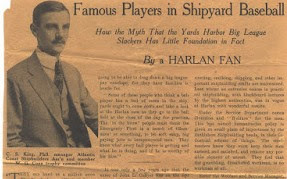
Despite the public outcry, work by the ballplayers at the shipyards continued throughout the war. How much work was done and how much baseball did the guys actually play? It's anyone's guess. For the record, they did play a lot of baseball. But a foreman at the ship yard told a reporter, "The boys in the yard all knew they [the ball players] were married men and hence not attempting to duck the draft and they warmed up with them right away when they observed that they meant business. . . and they weren't handed any soft jobs like watchmen . . . they do a good day's work." He added that they only went to the ball field at the close of the work day.
And much good came out of the ballplaying. They played a series of exhibitions for the Red Cross. One at the Polo Grounds, with Joe as the headliner, raised $6,000. Joe's wife would keep in her scrapbook a letter from a Reading, Pennsylvania organization thanking him for drawing 10,000 fans to a benefit.
The tumult over Joe soon faded from the public's attention as much more pressing matters arose and attention turned to the actual fighting in Europe. As for 1918, it turned out pretty well, Joe Jackson was the star of the Steel League, hitting a robust .393. Harlan won the championship--Joe hit two home runs in the title game--and, oh yeah, we won the war, which is always nice.
So everyone was in good spirits and ready to get back to baseball business as usual for 1919. There was only the small matter of rounding up the players. When the 1918 season had ended early on September 1, the owners had released all players, saving around $200,000 they would have otherwise spent on those pesky salaries. Amazingly, the next spring every single player--technically all free agents--signed back with their original team for 1919 (66 years later this practice would be labeled collusion and would cost the owners millions in a court settlement, but at the time a players union was as inconceivable as another, larger World War ever occurring).
As an example of just how much the owners had baseball writers in their pockets, the said writers soiled themselves attempting to educate fans on all that the owners had done for their country and baseball in general. "[The baseball] fan, when it's all over and the game comes back to its former basis, should remember how the . . . magnates acted in the hour of need." W. A. Phelon, wrote in Baseball Magazine. Not satisfied with mere praise, Phelon even suggested the public should give them a "Magnates' Day and a lot of floral tokens just to show that these gentlemen, after many years won the public heart at last?"
Early in 1919, Comiskey, that gentleman magnate, let it be known that Joe Jackson had been reinstated to his team. What with the war being won and all, opinions had changed and the big ol' lovable Roman was willing to let bygones be bygones--especially for guys who could hit .350 in their sleep and were willing to do so for a pittance. He signed Joe back for the same $6,000 a year he had been making since 1914.
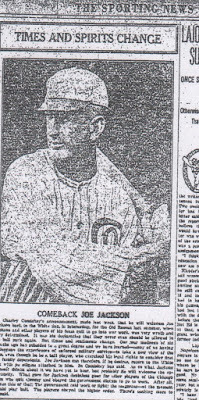
Joe Jackson and his White Sox teammates quickly proved to be the best in baseball in 1919 as they stormed toward the pennant, and a date with infamy.
So all the ingredients were there: the avarice of owners, the unrelenting drive of organized baseball and writers, working side-by-side, to maintain the proper image at all costs, sacrificing a few players if necessary, the cut-throat rivalry between Ban Johnson and Charles Comiskey, and the players, plugging along on the field, accepting the results of it all.
Shoeless Joe Jackson, the great misunderstood slugger from Greenville, South Carolina, whose legacy would be still provoking emotional debates a full century later, was, as so eloquently put by Mongo in Blazing Saddles, only a pawn in the game of life. Unfortunately for Joe, it wouldn't be the last time.
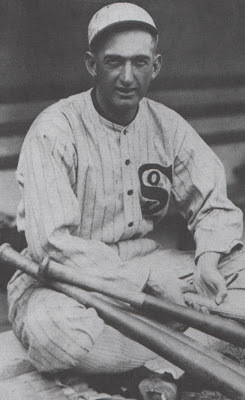
Published on February 09, 2017 16:08
November 21, 2016
It Happens Every Spring: Baseball's Infamous Relationships
Baseball fans were shocked by last week's tweet from Kate Upton about Justin Verlander losing the Cy Young Award vote. It wasn't the fact that a supermodel would express displeasure with voters for a baseball award or even her choice of verbiage that surprised them, however, it was the simple realization that here was news of a baseball player and his significant other that, for once, did not spell doom for the ballplayer. She was merely supporting her guy; which is always nice.
Fans have unfortunately grown accustomed over the years that when something involving a baseball player and his spouse or girlfriend hits the news it is invariably of such depravity and disgrace that fans must force themselves to watch and read about it over and over (and over and over).
I thought this might be a good time to review some of these unfortunate events if for no other reason than the season is over and there are no more games to talk about.
Alex Rodriguez eats popcorn:
Forget about the sulking postseason slumps, the steroid allegations and everything else. The single reason most baseball fans hated A-Rod was the unwanted spectacle of the camera catching his then-best girl Cameron Diaz feeding him popcorn during Super Bowl XLV in 2011. The sight of baseball's highest paid player smugly enjoying such contrived, domestic pseudo-bliss with a gorgeous actress was too much for anyone to bear without yakking in their nachos.
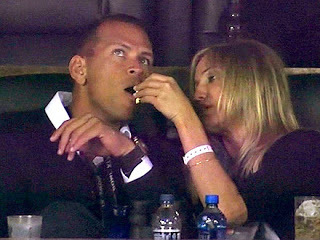
But in A-Rod's defense, what would you do? Some guys just likes popcorn.
Leo Durocher-Laraine Day
At the time Leo was the headline-grabbing, much-reviled manager of the Brooklyn Dodgers. Prematurely bald, loud, rude and selfish, he was also a snazzy dresser and reeked of confidence and masculinity. Since he was known to never lack for female companionship, apparently these latter qualities were considered somewhat desirable to the opposite sex when weighed against the former.
Laraine Day was a pretty young actress who starred in a number of B-level mediocre films, most notably seven Doctor Kildaire flicks as the main character's fiance. She and Leo met, and, in the manner of all classic stories, fell in love.
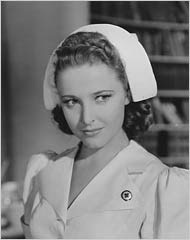
One slight technicality: Day was married with three adopted children at the time.
Nevertheless, in late 1946 the 26-year-old Day abruptly filed for divorce in California and took up with 41-year-old Leo the Lip. Divorce was not something to be entered into and obtained easily in those days. When she learned that state law required a one-year cooling-off period of separation, Day scurried to Mexico for a quickee divorce in December and married Leo there. There were complications as it would be a year before her divorce and new marriage would be recognized in the states.
Day's ex-husband, as might be expected from the jilted husband of a girl who looks that good in a nursing cap, was not pleased by the whole monkey business. He complained to reporters that Leo was not a fit or proper person to associate with and accused Leo of "dishonorable and ungentlemanly conduct" with his wife (anyone who had ever played baseball for or against Durocher would have wholeheartedly agreed with him on both accounts). Leo, who steadfastly believed that all was fair in love and war and baseball, neither denied nor apologized for anything.
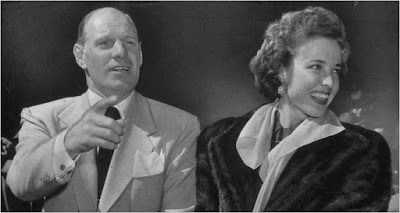
The scandal mushroomed in newspaper print. In February, 1947, the Catholic Youth Organization publicly denounced Leo's behavior as a poor example for youngsters and withdrew its support for the Dodger's Knothole Gang. Meanwhile, Durocher had already been suspected by the baseball commissioner's office of hanging out with undesirable gambling figures and he also became caught up in some skulduggery between the Yankee's Larry MacPhail and Branch Rickey. The end result (anyone can draw a conclusion as to which of the problems was the main cause) was that Leo was suspended by Commissioner Chandler for the year.
For her part, Laraine quickly charmed sportswriters and her new husband's players. Although there were later reports of some hard feelings due to disparaging remarks about players and umpires on her radio show, she became known as the "First lady of baseball."

The marriage, much to the amazement of anyone who knew Leo from the baseball field, lasted until 1960.
Johnny Bench's first marriage
In the early 1970s Johnny Bench was generally acknowledged as the most eligible bachelor in sports not named Joe Namath. He was perpetually seen with blond models on his arm and, in a nod to his hometown of Binger, Oklahoma, was referred to as the Swinger from Binger; and the name had nothing to do with his ability with a bat.
By the winter of 1974, the 27-year-old Bench had already appeared in seven All-Star games, won seven Gold Gloves, two Most Valuable Player Awards, two home run titles and three RBI titles. He owned the burg of Cincinnati.
In January, 1975 Bench made the grand announcement that he had become engaged and would be married in a few weeks. The mournful wail of gnashing of teeth loudly echoed throughout the Ohio Valley as female baseball fans learned the news. Several even called the Reds' office and demanded a refund for their season tickets.
The anguish of disappointed ladies-in-waiting notwithstanding, the news was otherwise greatly celebrated in the Queen City. It was as if a royal prince had ventured forth and returned to the realm bearing a princess.
Peasants of the Kingdom were informed that the lucky bride-to-be was Vickie Chesser, a former Miss South Carolina, 1970 Miss USA Runner-up and Ultrabrite toothpaste model.

The last title was not insignificant in the mid-70s, Ultrabrite toothpaste commercials, proclaiming to add sex appeal, had been the launching board for such luminaries as future Charilie's Angels Farrah Fawcett and Cheryl Ladd.
The whole affair dominated Cincinnati society columns, and the thoughts of the good citizens, for weeks. Vickie was feted at a never-ending parade of cocktails and dinners.
Details of the whirlwind courtship emerged in the newspaper and were fawned over by all. The uber-confident Bench had seen Vickie on TV, got her phone number from a friend and cold-called her apartment in New York City (not a baseball fan, she'd never heard of him) and convinced her to fly to Cincinnati to meet him for a date. The couple soon flew to Las Vegas to become better acquainted over the New Years weekend. By January 21 they were engaged. Vickie proclaimed to reporters that it was a "fairy tale love story."
The marriage was billed as the social event of the decade--perhaps the century--in Cincinnati and indeed it was. Some were disappointed to find out local TV was not carrying the event live. The much-talked-about guest list, which one Cincinnati Society column writer joked included "only the immediate city," actually included President Gerald Ford, Bob Hope, Dinah Shore, Joe DiMaggio and Jonathan Winters (they all sent their regrets).
The marriage took place February 21, 1975. More than 800 attended the ceremony, while a crowd estimated at 400 stood outside the church hoping to catch a glimpse of royalty and soak up some of the aura. The Cincinnati Enquirer ran a four-column, half-page photo of the happy couple smooching on the next day's front page, above the fold.
They honeymooned in Tampa, while Johnny went to work in spring training. While there, Vickie thoroughly charmed all sportswriters. She cooed and giggled and remarked how cute and adorable Johnny was with his little hat turned backwards when he caught and how serious he and his little friends seemed to be as they chased the ball around the field. The middle-aged wags ate it up.
.
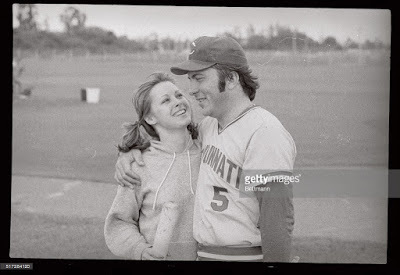
Unfortunately, the happiness was very shortlived. Apparently Vickie soon learned that the life of a baseball wife was not for her. By that fall observers noticed the couple was rarely seen together. By March, 1976, they announced they were divorcing.
Bench tried to take the high road and said publicly that it was a private matter, that they had agreed to disagree and refused to divulge any details or lay blame. Vickie, however, took a different approach.
She went public with a list of details and charges, mostly generic comments such as that he did not respect women and was "a true tragedy as a person," but the most famous of her specific complaints was that he had spent their wedding night playing ping pong with the best man. Sources later revealed that this was a complete falsehood--it was actually the computer pong game that they played.
Vickie returned to New York City, ostensibly to resume her modeling career, but was never heard from again.
The divorce was settled in 1977, reportedly with the stipulation that neither would ever be allowed to speak or publish details of the marriage.
While it was an embarrassing episode for the highly-image-conscious Bench, he emerged relatively unscathed.
Joe Jackson's Baseball Girls.
Just to let you know that interpersonal relations between men and women did indeed exist before 1920, I present a scandalous story from Shoeless Joe's past. In the winter of 1915, trying to supplement his salary of $6,000 a year from the Cleveland Indians, Jackson toured the south with a vaudeville act billed as "Joe Jackson's Baseball Girls." The act featured several girls who may have passed for attractive in those days, various skits that may have passed for humor, along with Joe giving a monologue referred to by one writer as "a sob rendition of how he rose from a minor place in the cotton mill to a major place in the baseball world." This is what people did for entertainment in the years before they could sit at home and watch reality TV.
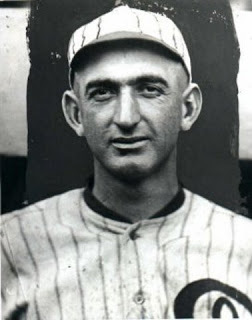
The faithful wife, Mrs. Katie Jackson, sitting at home with Joe's family in South Carolina during that winter, began to hear rumors drifting back that Joe was spending an inordinate amount of time after the shows with one of the "baseball girls." When Joe refused her demand to abandon the show and return home, stating that they had sold out the theater in Atlanta for two weeks running, Katie visited a lawyer and announced that she was considering filing for divorce--a notion so scandalous at the time that it was illegal in South Carolina (she would have had to file in their summer residence of Cuyahoga County, Ohio). Not leaving it with only that threat, Katie went to the sheriff of Greenville, South Carolina and swore out a warrant to have Joe, as a wayward husband, brought back home.
The sheriff dutifully took a train to Atlanta, went to Joe's hotel and served the warrant. Joe agreed and quickly packed his bags but on the walk to the station, the sheriff said something that angered the ballplayer and a scuffle ensued. The sheriff was KOed with one or two punches and Joe walked away.
Joe later reconsidered, boarded a train to Greenville, reported first to the sheriff to answer the legal charges, and then went home to face a much grimmer fate at the hands of his scorned wife. The whole scandal was much celebrated in papers of the day.
Joe and Katie quickly worked things out, however. All charges were dropped and the Jacksons lived a happy married life for the next 36 years; until death did them part.
The Fritz Peterson/Mike Kekich trade.
Fritz Peterson was a very good pitcher for the New York Yankees in the late '60s and early '70s. The lefthander won 20 games in 1970 and appeared in that year's All-Star game. And when the old Yankee Stadium was demolished years later, it was announced that Peterson, with a sparkling 2.52, had the all-time lowest ERA at the venerable House that Babe Built (Whitey Ford was second with 2.55). Unfortunately, casual baseball fans only know Peterson for a bit of off-field activity.
In March, 1973 Peterson and fellow Yankee pitcher (also lefthanded of course) Mike Kekich shocked the sports world by announcing that they were swapping wives, kids and dogs.
Kekich and Peterson had been friends and roommates since 1969 and their families had socialized together frequently. They noted that complicated feelings had developed and after intense consideration, came up with the plan for the trade. Peterson stated that they weren't just a bunch of swingers joining in the latest craze. He said that he hoped people "won't make anything sordid out of this."
But they did.
The deal made front-page news across the country. Most folks on the old side of the generational gap pointed to it as Exhibit A of the complete collapse of morals and western civilization being wrought by youngsters. Embarrassed club officials said little publicly, but apparently were willing to look the other way as long as the two helped their team win.
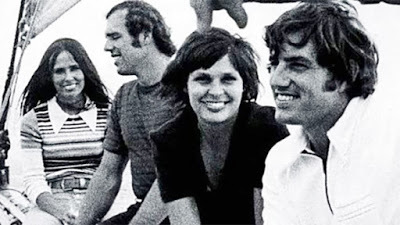
But it was not to be. The pair of pitchers endured boos and taunts all over the league and it appears their play suffered. Kekich, a mediocre pitcher before the swap, couldn't get anyone out, was sent to Cleveland before mid-season and his baseball career quickly fizzled. Peterson, who had averaged 17+ wins a year the previous four seasons, went 8-15 in 1973 and was traded to Cleveland in April, 1974, where he pitched fairly well, going 23-22 the next two years for a bad team.
Kekich, who enrolled in medical school after baseball and became a doctor, came out much worse on the trade. He and the former Mrs. Peterson did not stay together through the 1973 season.
Peterson and the former Mrs. Kekich, however, were still married after 42 years in 2015 when Peterson told an interviewer, "We're still having a blast."
Aroldis Chapman learns an important lesson (or did he?)
By the end of May, 2012, Chapman, aka the Cuban Missile, was the hottest thing in the majors. A 24-year-old, third-year lefty who lit up Juggs guns all over the league to the tune of 105 mph, he was sitting on a 6-year, $30 million contract and had not given up an earned run in his first 21 games of the season.
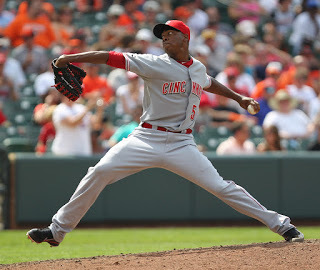
May 29, 2012, while the Reds played the Pirates, it was announced in a police report that a robber had ransacked Chapman's hotel room, tied up a 26-year-old female guest inside, and made off with a bag containing $200,000 worth of jewelry.
Hmmmm. Where do we start on this one? Guest? Jewelry? $200,000?
The "guest" said she answered a knock on the door to find a plumber who claimed to have been called for maintenance. Once inside, the plumber produced a gun and proceeded with his dastardly crime. Her story soon changed, however, to involve running into an unidentified man on the street who followed her back to the hotel. That one didn't stand up under questioning any better than the first.
Three weeks later police announced they were charging the lady, Claudia Marique, a stripper from Colombia, with false reporting. Her stories had continued to morph and she had failed a polygraph.
Turns out, she had been "dating" Chapman for a short time, meeting him at hotel stops around the league according to the Reds' schedule. It also turned out that she was married to someone else, but she defended herself by saying that the marriage wasn't important because it was only an arranged affair used for her to gain access to American soil. Also, she was apparently on the lamb because she owed thousands of bucks to a human smuggler.
She pleaded guilty in November, paid a menial $164 fine (police no doubt just happy to be rid of her) and went on her merry way. No mention was ever made about the jewelry.
Chapman, for his part, later told police he suspected she may have been in on the crime from the start (apparently the Reds were not paying him all that money for his ability to solve differential equations).
All of this raises the very important question every major league rookie should be asked each spring: "If you can't trust a married Colombian stripper to remain in your hotel room with $200,000 worth of jewelry while you are at the ballpark, who can you trust?"
Wade Boggs does more than eat chicken
In the late '80s casual fans knew two things about Boggs: due to superstition, he ate chicken before every game and he was one of the best pure hitters in the game, routinely hitting around .350. Unfortunately, they soon learned more about Boggs than they ever wanted to. . .
Margo Adams, a self-professed mortgage broker, stated that she had met the married Boggs in a restaurant in 1984 and soon became his regular side-piece, traveling throughout the league to accompany him on the road, claiming as many as 64 trips in one year. The fun lasted until 1988 when Boggs, no longer enthralled with what he felt was becoming a hen-pecking, demanding "partner," broke things off and reneged on an agreement to compensate her for lost wages while she was chasing him around on the road.
Adams did not take the rejection well.
She filed a palimony suit, eventually seeking $12 million. Boggs charged her with blackmail, fearing the release of numerous pictures. The public eventually got much more than pictures.
.
While Adams did not collect on her exorbitant demands (the court threw out $11.5 million and she and Boggs settled the $500,000 for an undisclosed amount), she hit the jackpot by cashing in on her newfound celebrity. She crossed the country in 1989 appearing on all the talk shows: Donahue, Larry King, Geraldo, and more. She was introduced by Arsenio Hall as "the most notorious woman in America," and appeared in a salacious cover (or uncovered, depending on your point of view) story in Penthouse. She made $250,000 from Penthouse alone.
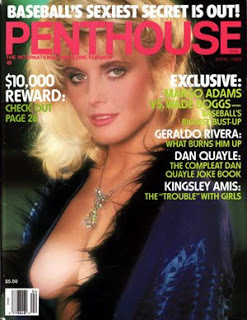
In all fairness to Adams, while there were those who considered her to be merely a bimbo spilling her guts for cash, she played the part very well and audiences loved her. She spared few details, was quick with double entendre one-liners and even claimed credit for his hitting prowess. "His [batting] average when [his wife] was with him was about .221," she said, "and his average when I was with him was .341." She openly compared Boggs' "talent" with that of another of her former baseball playing friends, Steve Garvey (hint: Boggs was a better singles hitter, but . . .).
She was swarmed by sportswriters at every stop. "What the hell, this is better than talking to Dwight Evans about his swing," quipped one Boston Globe writer.
Meanwhile, rather than take the time-honored ballplayer-defense of denying his butt off and verbally attacking his accuser, Boggs did a very strange thing: he admitted it and then went on television for an extended mea culpa. In a very disturbing and uncomfortable (for viewers) interview on 20/20 with Barbara Walters, sitting between her and his wife, who remained faithfully by his side for more that three decades, he admitted that he was a sex addict (baseball fans had never suspected that was even a thing).
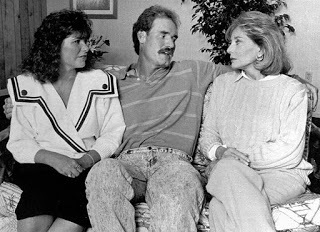
While Adams was quickly forgotten, Bogg's reputation was never the same.
Wade, Wade, Wade. There are some things best left unsaid.
Chuck Finley gets bit by a whitesnake
Chuck Finley pitched in the major leagues for 16 years, compiled a record of 200-173 and is one of the best pitchers in California Angels history, but he will forever be known for the rocky ending to his five-year marriage to Ms. Tawny Kitaen.
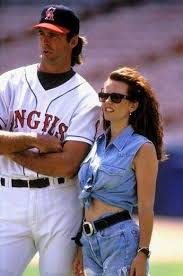
Kitaen, who had previously been married to David Coverdale, leadsinger of the hairband Whitesnake, and famously slithered all over the hood of a car in their 1987 video "Here I Go Again," was arrested by Newport Beach, California police in April 2002 after a 911 call. She apparently had become enraged and began beating Finley with, among other things, a stiletto heel while he was driving their car.
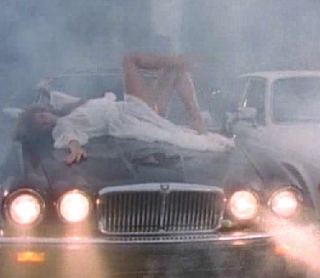
Finley soon filed for divorce and the marriage ended. But the jokes and sneers at his expense did not. When he pitched in Chicago against the White Sox later that month, the director of stadium music queued up "Here I go Again" on the sound system (he was later fired and the team apologized), and late-night comics welcomed the addition to their material.
Kitaen, who also starred opposite a young Tom Hanks in the 1984 film Bachelor Party (their respective careers went in slightly different directions afterward) later underwent successful drug rehab and the couple, while no longer married, was reportedly on good terms when last heard from.
Eddie Waitkus becomes a natural
The Eddie Waitkus story is the granddaddy of all cautionary baseball-chick tales. Waitkus was a single, talented player for the Chicago Cubs and Phillies; an All-Star in 1948 and 1949. Waitkus had received four Bronze Stars for his participation in savage action in the Pacific during World War II, but this experience did little to prepare him for what happened in a Chicago hotel room in 1949.
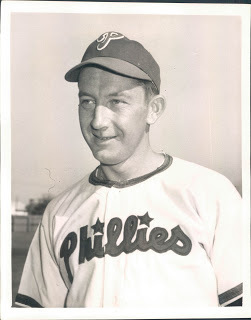
On the night of June 14, 1949, while the Phillies were in Chicago, the 29-year-old Waitkus returned to the team's hotel, the Edgewater Hotel, around 11 PM and found a note: "It's extremely important I see you as soon as possible. We're not acquainted but I have something of importance to speak to you about. Ruth Ann Burns, Room 1279-A."
Waitkus made his way to Room 1279-A where 19 year old Ruth Ann Steinhagen was waiting for him. He later noted that she had a fixed, almost zombie-like expression and acted somewhat peculiar when he entered. But enter he did and as he sat down she told him, "I have a surprise for you." She went to the closet and pulled out a .22 caliber rifle.
"For two years you've been bothering me," she said according to the New York Times account, "and now you're going to die." With that she shot Waitkus in the chest. She then called the hotel operator and to report the shooting and was found on her knees, cradling his head when authorities rushed to the room.
The news was sensational.
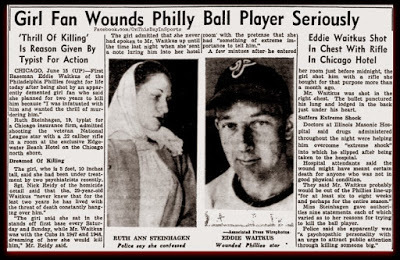
Steinhagen was arrested and charged, however, less than three weeks later a judge declared her insane and ordered her confined to a psychiatric hospital.
The story emerged of one of the earliest cases of criminal stalking. A Cubs fan, she had become infatuated with Waitkus when he played in Chicago. According to her family, she collected photos of Waitkus and talked about him incessantly. "I used to go to all the ballgames just to watch him," she later wrote in a court-ordered autobiographical statement. She suffered a breakdown when he was traded to the Phillies after the 1948 season. She began acting erratically and built an elaborate shrine to Waitkus in her room. Finally realizing that she could never meet him under normal circumstances, she resolved, "if I can't have him nobody else can."
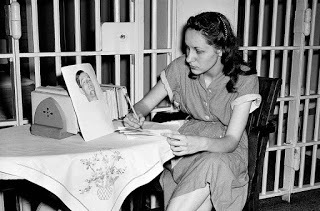
She was declared cured and released after 3 years and lived quietly with family until her death in 2013.
Waitkus narrowly survived. The bullet pierced on of his lungs and lodged near his heart.
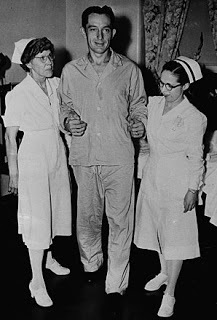
But he was back in the Phillies Opening Day lineup, going 3-for-5 to start the next season. Waitkus played six more years after the shooting, getting in the 1950 World Series but was never the same ball player. He reportedly never showed any anger toward Steinhagen, but instead accepted the fact that she was sick and he was the unfortunate victim.
After the Waitkus incident players all over the majors cautiously checked closets before entertaining female friends--at least for a few weeks.
Published on November 21, 2016 11:58
November 10, 2016
Veteran's Day Salute: Phil Marchildon, major league pitcher, tail gunner, POW
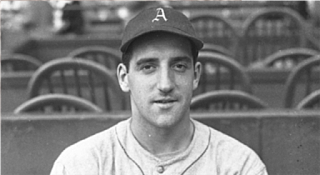
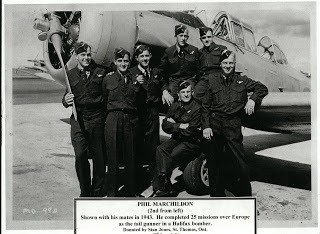
It always amazes me when I read about the sacrifice so many major league players made during World War II. Yes, it was a different time and a different type of war, but for the most part they all joined in when called, with little public grumbling. Few of them had any idea of what they might be getting themselves into, or of the horrors they might see, but they went and did what they were told. And many of them were changed forever by what they experienced.
I recently came across the story of Phil Marchildon. He is not a household name. But he should be remembered.
Phil was born in Ontario in 1913. Raised in a struggling family during the depression, his destiny appeared to be working in a nearby nickel mine. His life's course was altered, however, when he starred for the company baseball team as a pitcher with a blazing fastball. A friend arranged a tryout with the Toronto Maple Leafs of the International League. Even though at 25 he was a little old to be starting a professional baseball career, he was signed and two years later was pitching in the major league for Connie Mack's Philadelphia A's.
In 1942, fresh off an impressive 17-win season, Phil was inducted into the Canadian military. As a known professional athlete, he was given the opportunity to remain in North America as a physical trainer but he opted instead for the Royal Canadian Air Force. "I didn't want people saying that Phil Marchildon, the big-league ballplayer, had taken the easy way out," he later wrote.
Judged too old to start training as a pilot, Phil was made a gunner--because of his excellent eyesight and depth perception, he was told. He was assigned to a Halifax bomber crew as a tail-gunner and soon found himself in England, ready to battle the Germans for control of Europe.
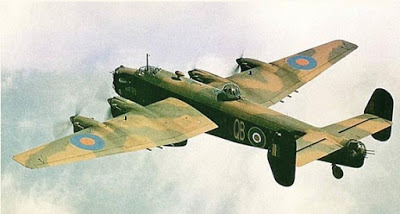
The Halifax was a bulky four-engined bomber, not unlike a flying crate. And it was not built with stealth in mind. When the beasts filled the sky on a mission, the ground trembled and the noise reverberated for miles, announcing their arrival to all.The fact that it had a target painted on it's butt did little to inspire confidence in the crew.
On missions, the Halifax flew in a slow, tight formation without maneuvering to evade the enemy. The defense of each plane was based on maintaining the integrity of the formation; each gun was vital to the protection of its neighbors.
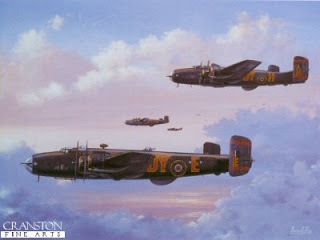
The Halifax compensated for the lack of speed and deception with dependability and the ability to take a punch. This came in handy on one of Marchildon's early missions in which he heard a loud noise from his plane amid heavy antiaircraft artillery and felt a shudder. When they made it back to base they counted 30 shrapnel holes in the bomber, including one perilously close to the fuel tank.
Marchildon and his 6-man crew flew out of a base in Yorkshire. Their early missions included softening up the Germans in France in advance of the Normandy invasion.
It was harrowing duty. The Halifax flew night missions. The gunners sat cramped and uncomfortable -- so cold their guns sometimes froze--and strained their eyes scouring the sky for enemy fighters. Once the danger of fighters was passed, another terror awaited--anti-aircraft fire. The crew could do little but helplessly sit and wait as shrapnel burst all around; and occasionally watch as fellow planes fell from the sky.
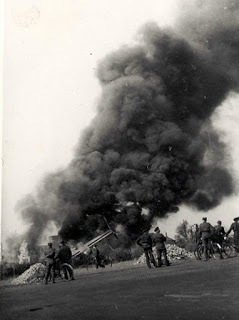
The tail gunner sat alone in the rear of the plane, completely exposed with nothing but a sheet of plexiglass and open air between him and shrapnel and enemy fighters. Moreover, the enemy fighters knew where the guns were located in the formation and planned their attacks accordingly. Tail gunners had the lowest survival rate of any bomber crew.
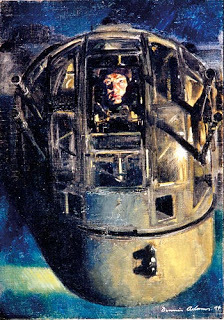
While the Americans faced enormous risks during their daylight bombing, night duty held terrors of its own. "In the day you can't see the stuff shooting up at you," Marchildon explained in a Sporting News interview in July, 1945. "But at night, Wow! It's tracers and rockets all around that scare you to death." Also by the time Marchildon arrived in Europe, the Germans were employing powerful searchlights that scanned the night sky looking for targets.
On the night of August 16, 1944, Marchildon and his crew took to the sky. They had already endured 25 missions; only 5 short of completing their tour. A German fighter surprised them before they reached their target, however, and in a flash the bomber was crippled and on fire at 17,000 feet. The Captain gave the order to bail out. Aware that everything could explode into a ball of flames at any second, Phil plunged into the darkness and felt his parachute jerk open, not knowing if he was over land or water.
Phil splashed down into the icy Baltic Sea, near the Denmark-German border. After clearing the entanglements of his parachute, Phil heard his friend, the navigator, screaming for help. It was well-known that the navigator couldn't swim. Phil managed to maneuver over through the crashing waves and calmed him down, assuring him that the life jacket would do its job. The navigator later credited Phil with saving his life. They never saw any of their other buddies again (it was later confirmed that all the others had died in the crash).
The pair floated in the rough sea for several hours, nearly succumbing to hypothermia before they were plucked by a Danish fishing trawler. But the danger was far from over. A German patrol was waiting for them when they pulled into port. They were prisoners of war.
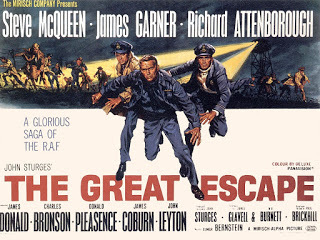
Phil was taken to the infamous Stalag III, which held more than 10,000 Allied prisoners. Six months earlier a large breakout, later made famous by the Steve McQueen movie The Great Escape, had taken place at Stalag III. The attempt had been largely unsuccessful as 50 of the 76 escapees had been shot to death by the Germans.
While captive, Phil suffered from dysentery and lost almost one-third of his weight. As the war neared its end, the prisoners were hastily roused one morning and told to line up for a march. Not knowing where or why, many fearing the worst, they were led on several forced marches over the next few weeks--they later learned they were being moved to keep ahead of the advancing allies. Finally they were liberated by a British patrol in May, 1945.
The war had ended for Phil Marchildon, but the fight was far from over.
Phil returned to the United States, married his pre-war girl and resolved to regain weight, get in shape and resume his baseball career. After pitching briefly for publicity at the behest of owner Connie Mack near the end of the 1945 season, Phil was back good as ever in 1946, winning 13 games. In 1947 he was 19-9 for a lousy A's team in one of the best years a Canadian pitcher not named Fergie Jenkins ever had.
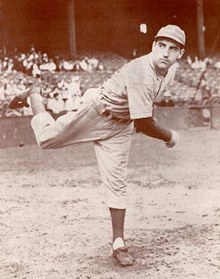
But it was not to be a Hollywood, feel-good ending for Phil Marchildon. He began to be plagued by nightmares and grew distant from teammates. While warming up before a game in 1948, he experienced an episode of severe dizziness and numbness. The ball felt like dead weight; his body felt drained of all strength. He went home and the next day was back to normal but the episodes began to come and go without warning and with increasingly alarming frequency. He began chain-smoking and was noted to be irritable. Phil's record in 1948 sank to 9-15.
Phil never talked about his war experiences with anyone. Teammates were confused. "My, he had good stuff," shortstop Eddie Joost said years later. "He could throw the ball as hard as anybody. We called him 'Fidgety Phil.' He could never sit still or stop moving his hands. I was told he had been gassed during the war and that had changed him. . . . He'd often get into what I called 'thinking trauma,' and would wander behind the mound, fool around with the resin bag, and hit his palm with his glove for maybe thirty seconds. You'd know something was wrong. . . . Every once in a while he'd start to shake and not be able to concentrate. We'd walk to the mound, but we couldn't settle him down."
"[Older players had said] he had been confident and gung-ho [before the war]," said third baseman George Kell, a teammate in 1945 and 1946. "The way I heard it, and I never could get it confirmed, was that he had been a prisoner of war. All the guys told me that he became a different fellow. He could still pitch, but he had a funny look in his eye that hinted his thoughts were about the war and not baseball. He was extremely nervous."
After the disappointing 1948 season in which his mental and physical condition had deteriorated alarmingly, Phil checked into a Toronto VA hospital. When physical tests were normal, he was told to "lighten up" and consider all the blessings he had.
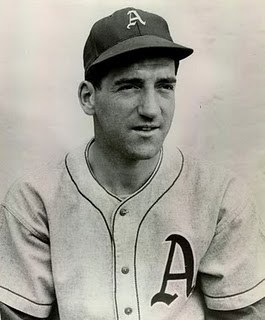 In 1948 the term Post-Traumatic Stress Disorder did not even exist. No one knew how to treat it. Phil was left alone to sort out his problem. "On every mission I'd spent hours scanning the sky for night fighters, always fearing the worst," Phil later wrote. "During the march I never knew what to expect . . . a guard might shoot me because he was in a bad mood that day. . . No one around me seemed to understand the emotions I was experiencing."
In 1948 the term Post-Traumatic Stress Disorder did not even exist. No one knew how to treat it. Phil was left alone to sort out his problem. "On every mission I'd spent hours scanning the sky for night fighters, always fearing the worst," Phil later wrote. "During the march I never knew what to expect . . . a guard might shoot me because he was in a bad mood that day. . . No one around me seemed to understand the emotions I was experiencing.""My hands shook as if I had palsy, and I was constantly on edge. My biggest struggle was overcoming the left over fear that something terrible was going to happen."
"I'd kind of drift away from concentration. I'd think about how lucky I was to get out of it all." Along with the feeling of luck, was guilt over surviving instead of his comrades.
Phil's baseball career unraveled. He hurt his shoulder in 1949, was ineffective and finally released by the A's. He caught on with the Red Sox for one game in 1950, then his baseball career was over.
Phil struggled after baseball but, with the help of his patient wife, eventually recovered. He worked at a Toronto furniture factory until retiring at 65. He was inducted into the Canadian Sports Hall of Fame, published his memoirs in a very good book, Ace: Phil Marchildon, and lived a full life. He died in 1997 at the age of 84.
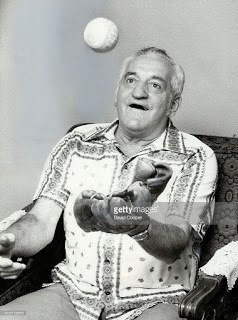
As Veteran's Day approaches we should pause to remember--and thank--Phil Marchildon, and everyone who fought with him, for sacrificing so much so that we have had the opportunity to keep playing ball for generations.
Published on November 10, 2016 04:58
November 4, 2016
Fifty Years Ago the Orioles Stunned the Dodgers With the Most Dominant World Series Pitching Ever
When the Indians pitching staff threatened to send this postseason back into the deadball era after the first four games, I was reminded that it was exactly fifty years since the greatest World Series pitching performance by a team: 1966, Baltimore vs. L.A.
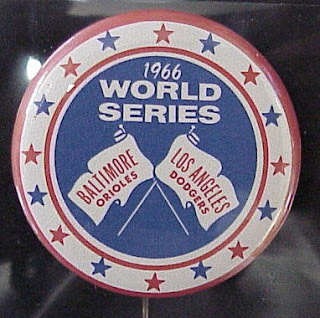 The Orioles had been in existence barely a decade and although they had threatened in recent years, this was their first pennant. They had bludgeoned the American League and clinched with weeks to spare. While they still relied on the Paul Richards-Oriole Way foundation of defense and great pitching, the 1966 version of the batting order had some definite muscle, and not just that provided by the great off-season addition of Frank Robinson. All season, the one-two-three punch of Frank, Brooks Robinson and Boog Powell had devastated opposing pitchers. At least two of the three were hot at any one time. Brooks finished with 23 homers, 100 RBIs, Boog 34 and 109, and Frank ended with triple crown numbers: 49 homers, 122 RBIs and a .316 average. They were 1, 3 and 4 in the league in RBIs. Brooks would finish second to Frank in the MVP voting, with Boog third. In addition to their offense, the Oriole defense boasted one of the best infields in history, with perennial Gold Glovers Robinson and Luis Aparicio making the left side near impenetrable and soon-to-be Gold Glover Davey Johnson at second.
The Orioles had been in existence barely a decade and although they had threatened in recent years, this was their first pennant. They had bludgeoned the American League and clinched with weeks to spare. While they still relied on the Paul Richards-Oriole Way foundation of defense and great pitching, the 1966 version of the batting order had some definite muscle, and not just that provided by the great off-season addition of Frank Robinson. All season, the one-two-three punch of Frank, Brooks Robinson and Boog Powell had devastated opposing pitchers. At least two of the three were hot at any one time. Brooks finished with 23 homers, 100 RBIs, Boog 34 and 109, and Frank ended with triple crown numbers: 49 homers, 122 RBIs and a .316 average. They were 1, 3 and 4 in the league in RBIs. Brooks would finish second to Frank in the MVP voting, with Boog third. In addition to their offense, the Oriole defense boasted one of the best infields in history, with perennial Gold Glovers Robinson and Luis Aparicio making the left side near impenetrable and soon-to-be Gold Glover Davey Johnson at second.
The Oriole pitching staff, while solid, was considered to be a potential weakness going into the Series. Twenty-year-old Jim Palmer led the staff with 15 wins and lefty Dave McNally was second with 13. The rest of the Orioles starters had battled sore arms all year, with manager Hank Bauer cobbling together whoever was healthy at the time to fill out his rotation. While the Orioles coasted through September, the winner in the National League was not decided until the Dodgers won the second game of a double header the last day of the season. The Dodger strength was their legendary pitching staff. Sandy Koufax boasted a record of 27-9 in 1966, with an ERA of 1.73 and 317 strike outs. In addition to Koufax, the Dodger rotation contained two other future Hall of Famers, Don Drysdale and twenty-year-old Don Sutton, as well as 17-game winner Claude Osteen. The Dodger pitching was rock-solid, but their ability to score runs was an entirely different matter. Second baseman Jim Lefebvre was the big gun, so to speak, of the L.A. offense: a .274 batting average with 24 home runs and 74 RBIs. Lou Johnson was second on the team with 17 homers and 73 RBIs. The Dodger game plan was to play a brand of small ball more suited to marbles, stringing together enough bunts, steals and infield hits to squeeze out a run or two and then hope their pitching staff could hold on. It was a formula that had worked well enough to win a tough National League pennant race, but no one was confusing them with the '27 Yanks. The Dodger hitters indeed did nothing to inspire fear, except among their own fans. In a bit of foreshadowing to the series, the New Hampshire Forestry Division sent a message to the Dodgers congratulating them for being the major league team “which has done the most to conserve wood—one of our most important natural resources.” Although the Orioles were strong, the Dodgers were still, well, THE DODGERS, winners of the World Series in 1963 and 1965. Among the Orioles, only Frank (Cincinnati in 1961), Aparicio (Chicago in 1959) and reliever Stu Miller (San Francisco in 1962) had been to a Series before and none had played on a winner. And so, despite the anemic L.A. offense, bookmakers had the Dodgers favored 8 to 5. Few could have predicted what would happen.
Because the San Francisco Giants had rudely refused to concede, winning their last six games, the Dodgers had entered the second game of a double header October 2, the last day of the season, needing a win to avoid dropping into a tie. Sandy Koufax had been pressed into service and threw a complete game, so he was not available on two days rest for Game One of the World Series. Dodger Game One starter Don Drysdale, Robin to Koufax' Batman, was not viewed as a huge step down, however. With his menacing presence on the mound, 6-foot-5, featuring a whip-like delivery that was almost side-armed, Drysdale had the ability to keep right-handers loose in the box and was well on his way to a Hall of Fame career of his own.
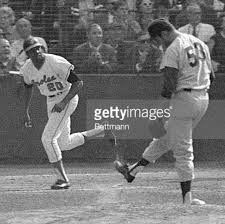
But in the top of the first inning with one out and Russ Snyder on first, the Robinson boys struck. Frank bombed a home run. Brooks stepped in. Drysdale, snarling and nasty, threw the obligatory duster high and inside. The second pitch was a fastball and Brooks turned on it and drove it seven rows deep in the left field stands giving the Orioles a quick 3-0 lead. The Dodger Dogs were barely warm in the concession stands and the Orioles had already scored as many runs as the Yankees (one in two games) and the Twins (two in three games) had in the past two World Series in Dodger Stadium. No one knew it at the time, but the Series was essentially over.But there was still a little drama. After watching his lead grow to 4-0, Oriole starter Dave McNally experienced control problems and was soon in deep trouble. Unable to get used to the severe slope of the mound, he was consistently wild-high. He gave up a run in the second, then walked the bases loaded in the third, throwing only three strikes to his last four batters. Oriole reliever Moe Drabowsky then walked out of the bullpen and into baseball history. . Drabowsky had been a flame-throwing phenom when signed in 1956 by the Cubs, but arm trouble quickly hampered his progress. By 1966, he had bounced between four different teams and had not had a winning record since 1960. After being converted to a full-time reliever by the Orioles, Drabowsky had turned in the best season of his career, going 6-0. Drabowsky struggled with his own control initially, walking Jim Gilliam on a 3-2 count to force in a run, and going 3 and 2 on John Roseboro. The Dodger catcher then fouled off an obvious ball four and popped out on the next pitch to end the inning. Drabowsky had a good arm and, when he was right, possessed an excellent fastball that was capable of overpowering hitters. It quickly became apparent that Moe was throwing particularly hard on this day. When Dodger teammates asked Lou Johnson, who struck out leading off the next inning, what Drabowsky’s pitches were doing, he replied, “They aren’t hitting the bat.” Drabowsky proceeded to have the best game any reliever has ever had in a World Series—he struck out eleven men (all swinging) over the last six and two-thirds innings (six in a row at one stretch) while limiting the Dodgers to one hit. The Orioles won the game 4-2. Game One set the tone. The rest of the Oriole staff, including Game Two starter Jim Palmer, couldn't help but note that what their advance scout Jim Russo had told them about the Dodgers was true--they could be beaten with high hard stuff.
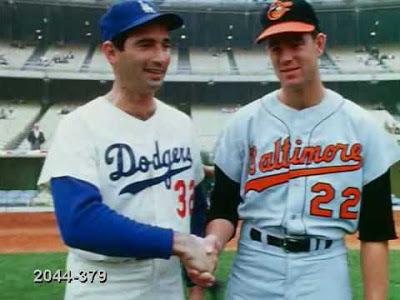
Sandy Koufax took the mound for the Dodgers under the bright West Coast sun for Game Two. Koufax had just completed one of the most dominating four-year stretches in major league history, with a record of 97-27, leading the league in ERA all four years (his worst ERA of that stretch was 2.07). Facing Koufax was twenty-year old Jim Palmer. Nicknamed Pancake that year due to his superstition of always eating pancakes the day he pitched, he had inflamed a tendon in his right shoulder while painting the nursery in his house earlier in the season (he was making $7500 that year and could not afford a painter). He entered the World Series concerned about his arm.But Koufax had concerns of his own. Although he was still a young man, only 30 years old, his left arm had aged in dog-years. It was not fully known at the time of the Series, but he had been in severe pain all year. He had thrown 323 innings during the season and had started seven games in the last 26 days of the season—the Dodgers had needed every one of them as they battled to the last game for the pennant. The World Series start was his third in eight days. While Koufax was not overpowering in Game Two, he was still good enough to win, had he gotten a little support with the leather. The Orioles could not manage a run through the first four innings, then in the fifth they received a gift. Dodger center fielder Willie Davis lost two consecutive fly balls in the sun, then picked up the ball and made a bad throw to third for another error. When the carnage was over, Davis had a World Series record three errors in one inning and the Orioles had a 3-0 lead. The comedians in the press box were having a good time at Davis’ expense. When he was late coming out for the next inning, one of them asked, “Do you suppose he may be about to commit suicide?” Another answered, “Hope not, he might miss and kill an usher.” A third pondered, “I wonder if Davis will be able to catch the plane to Baltimore.”
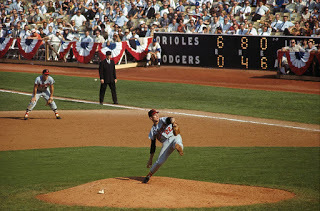
The Dodgers were unable to score off Palmer and the Orioles added three more runs, courtesy of a total of six Dodger errors. Palmer finished with a complete game four-hit shutout.
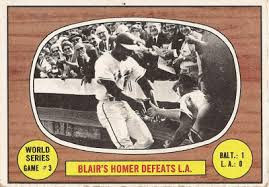
The teams traveled to Baltimore for Game Three. The Orioles’ Game Three starter, 21-year-old Wally Bunker, had been 19-5 in 1964, but had experienced arm trouble ever since. Although not technically a power pitcher, he smartly followed the recipe of Drabowski and Palmer and fed the Dodgers fastballs. And once again the recipe produced a masterpiece. Bunker was in control the whole game, scattering 6 hits and a walk. Only two Dodgers reached second base. Dodgers pitchers Claude Osteen and Phil Regan nearly matched Bunker, giving the Orioles only 3 hits, but one was a big one, a fifth-inning home run by Paul Blair. The blast stood up as only the third time in history a 1-0 World Series game had been decided by a home run. After the game Bunker sat in front of his locker, all but neglected by the press. “I guess shutting out the Dodgers isn’t news anymore,” he joked. Apparently, it wasn't. In Game Four the Dodgers came back with Drysdale, holding Koufax ready for the next game if needed. A fourth-inning two-out Frank Robinson home run gave the Orioles a 1-0 lead. Boog Powell followed with a towering drive to deep center field that appeared to add to the lead. Willie Davis turned his back and ran to the fence, waited, took five steps to his right--just in front of the 410 sign--and jumped. With the armpit of his fully extended right arm above the fence, he caught the ball to rob Powell of a home run.
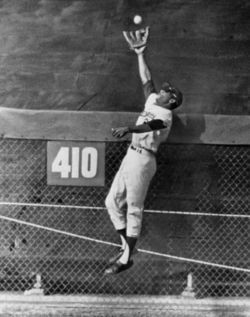
The great play in center field gave the Dodgers a spark of life as they prepared to hit. Jim Lefebvre opened the inning with a single. The next batter, Wes Parker slapped a bouncer into the hole to Aparicio’s right. Brooks Robinson ran to his left, stretched and stabbed the ball, stumbled, took a couple of steps to regain his balance, then delivered a perfect chest-high throw to Johnson at second who relayed it quickly to first for a double play. The Dodger momentum was over.There were still tense moments, however. In the eighth, Lefebvre drilled a long fly to center that looked like a tying home run. Blair ran back, leaped at the fence and robbed him (a spectacular play, but not quite as good as Davis’ at nearly the same spot in the fourth). In the ninth inning, with one out and the Orioles clinging to a 1-0 lead and starter Dave McNally still on the mound, pinch hitter Al Ferrara singled to center and was replaced by a pinch runner. McNally walked the next batter, giving the Dodgers their most serious threat in nearly a week. Willie Davis then popped out to right field, too shallow for the runners to advance. With the crowd roaring on every pitch, Lou Johnson worked the count to 2-2, then lifted a can of corn to Blair in center to end the series.
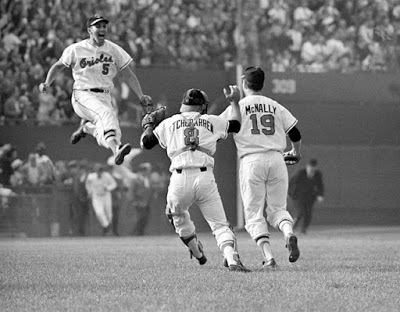
The pitching dominance was startling. Throwing mostly high fastballs, Oriole pitchers had blanked the Dodgers for the final 33 innings of the Series—giving them no runs after the fourth inning bases-loaded walk in Game One. More astounding, the Dodgers only advanced one runner to third base over the final 25 innings. Palmer, Bunker and McNally threw consecutive shutouts. The Series set a record for low batting averages: .147 for the Dodgers and .200 for the winning Orioles. The Orioles did not commit an error in the four games. Manager Hank Bauer, playing the hot hand, used only 13 men the whole Series and--modern managers take note--used a grand total of four pitchers the entire Series.
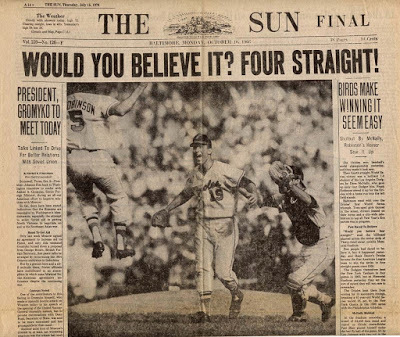
 The Orioles had been in existence barely a decade and although they had threatened in recent years, this was their first pennant. They had bludgeoned the American League and clinched with weeks to spare. While they still relied on the Paul Richards-Oriole Way foundation of defense and great pitching, the 1966 version of the batting order had some definite muscle, and not just that provided by the great off-season addition of Frank Robinson. All season, the one-two-three punch of Frank, Brooks Robinson and Boog Powell had devastated opposing pitchers. At least two of the three were hot at any one time. Brooks finished with 23 homers, 100 RBIs, Boog 34 and 109, and Frank ended with triple crown numbers: 49 homers, 122 RBIs and a .316 average. They were 1, 3 and 4 in the league in RBIs. Brooks would finish second to Frank in the MVP voting, with Boog third. In addition to their offense, the Oriole defense boasted one of the best infields in history, with perennial Gold Glovers Robinson and Luis Aparicio making the left side near impenetrable and soon-to-be Gold Glover Davey Johnson at second.
The Orioles had been in existence barely a decade and although they had threatened in recent years, this was their first pennant. They had bludgeoned the American League and clinched with weeks to spare. While they still relied on the Paul Richards-Oriole Way foundation of defense and great pitching, the 1966 version of the batting order had some definite muscle, and not just that provided by the great off-season addition of Frank Robinson. All season, the one-two-three punch of Frank, Brooks Robinson and Boog Powell had devastated opposing pitchers. At least two of the three were hot at any one time. Brooks finished with 23 homers, 100 RBIs, Boog 34 and 109, and Frank ended with triple crown numbers: 49 homers, 122 RBIs and a .316 average. They were 1, 3 and 4 in the league in RBIs. Brooks would finish second to Frank in the MVP voting, with Boog third. In addition to their offense, the Oriole defense boasted one of the best infields in history, with perennial Gold Glovers Robinson and Luis Aparicio making the left side near impenetrable and soon-to-be Gold Glover Davey Johnson at second.The Oriole pitching staff, while solid, was considered to be a potential weakness going into the Series. Twenty-year-old Jim Palmer led the staff with 15 wins and lefty Dave McNally was second with 13. The rest of the Orioles starters had battled sore arms all year, with manager Hank Bauer cobbling together whoever was healthy at the time to fill out his rotation. While the Orioles coasted through September, the winner in the National League was not decided until the Dodgers won the second game of a double header the last day of the season. The Dodger strength was their legendary pitching staff. Sandy Koufax boasted a record of 27-9 in 1966, with an ERA of 1.73 and 317 strike outs. In addition to Koufax, the Dodger rotation contained two other future Hall of Famers, Don Drysdale and twenty-year-old Don Sutton, as well as 17-game winner Claude Osteen. The Dodger pitching was rock-solid, but their ability to score runs was an entirely different matter. Second baseman Jim Lefebvre was the big gun, so to speak, of the L.A. offense: a .274 batting average with 24 home runs and 74 RBIs. Lou Johnson was second on the team with 17 homers and 73 RBIs. The Dodger game plan was to play a brand of small ball more suited to marbles, stringing together enough bunts, steals and infield hits to squeeze out a run or two and then hope their pitching staff could hold on. It was a formula that had worked well enough to win a tough National League pennant race, but no one was confusing them with the '27 Yanks. The Dodger hitters indeed did nothing to inspire fear, except among their own fans. In a bit of foreshadowing to the series, the New Hampshire Forestry Division sent a message to the Dodgers congratulating them for being the major league team “which has done the most to conserve wood—one of our most important natural resources.” Although the Orioles were strong, the Dodgers were still, well, THE DODGERS, winners of the World Series in 1963 and 1965. Among the Orioles, only Frank (Cincinnati in 1961), Aparicio (Chicago in 1959) and reliever Stu Miller (San Francisco in 1962) had been to a Series before and none had played on a winner. And so, despite the anemic L.A. offense, bookmakers had the Dodgers favored 8 to 5. Few could have predicted what would happen.
Because the San Francisco Giants had rudely refused to concede, winning their last six games, the Dodgers had entered the second game of a double header October 2, the last day of the season, needing a win to avoid dropping into a tie. Sandy Koufax had been pressed into service and threw a complete game, so he was not available on two days rest for Game One of the World Series. Dodger Game One starter Don Drysdale, Robin to Koufax' Batman, was not viewed as a huge step down, however. With his menacing presence on the mound, 6-foot-5, featuring a whip-like delivery that was almost side-armed, Drysdale had the ability to keep right-handers loose in the box and was well on his way to a Hall of Fame career of his own.

But in the top of the first inning with one out and Russ Snyder on first, the Robinson boys struck. Frank bombed a home run. Brooks stepped in. Drysdale, snarling and nasty, threw the obligatory duster high and inside. The second pitch was a fastball and Brooks turned on it and drove it seven rows deep in the left field stands giving the Orioles a quick 3-0 lead. The Dodger Dogs were barely warm in the concession stands and the Orioles had already scored as many runs as the Yankees (one in two games) and the Twins (two in three games) had in the past two World Series in Dodger Stadium. No one knew it at the time, but the Series was essentially over.But there was still a little drama. After watching his lead grow to 4-0, Oriole starter Dave McNally experienced control problems and was soon in deep trouble. Unable to get used to the severe slope of the mound, he was consistently wild-high. He gave up a run in the second, then walked the bases loaded in the third, throwing only three strikes to his last four batters. Oriole reliever Moe Drabowsky then walked out of the bullpen and into baseball history. . Drabowsky had been a flame-throwing phenom when signed in 1956 by the Cubs, but arm trouble quickly hampered his progress. By 1966, he had bounced between four different teams and had not had a winning record since 1960. After being converted to a full-time reliever by the Orioles, Drabowsky had turned in the best season of his career, going 6-0. Drabowsky struggled with his own control initially, walking Jim Gilliam on a 3-2 count to force in a run, and going 3 and 2 on John Roseboro. The Dodger catcher then fouled off an obvious ball four and popped out on the next pitch to end the inning. Drabowsky had a good arm and, when he was right, possessed an excellent fastball that was capable of overpowering hitters. It quickly became apparent that Moe was throwing particularly hard on this day. When Dodger teammates asked Lou Johnson, who struck out leading off the next inning, what Drabowsky’s pitches were doing, he replied, “They aren’t hitting the bat.” Drabowsky proceeded to have the best game any reliever has ever had in a World Series—he struck out eleven men (all swinging) over the last six and two-thirds innings (six in a row at one stretch) while limiting the Dodgers to one hit. The Orioles won the game 4-2. Game One set the tone. The rest of the Oriole staff, including Game Two starter Jim Palmer, couldn't help but note that what their advance scout Jim Russo had told them about the Dodgers was true--they could be beaten with high hard stuff.

Sandy Koufax took the mound for the Dodgers under the bright West Coast sun for Game Two. Koufax had just completed one of the most dominating four-year stretches in major league history, with a record of 97-27, leading the league in ERA all four years (his worst ERA of that stretch was 2.07). Facing Koufax was twenty-year old Jim Palmer. Nicknamed Pancake that year due to his superstition of always eating pancakes the day he pitched, he had inflamed a tendon in his right shoulder while painting the nursery in his house earlier in the season (he was making $7500 that year and could not afford a painter). He entered the World Series concerned about his arm.But Koufax had concerns of his own. Although he was still a young man, only 30 years old, his left arm had aged in dog-years. It was not fully known at the time of the Series, but he had been in severe pain all year. He had thrown 323 innings during the season and had started seven games in the last 26 days of the season—the Dodgers had needed every one of them as they battled to the last game for the pennant. The World Series start was his third in eight days. While Koufax was not overpowering in Game Two, he was still good enough to win, had he gotten a little support with the leather. The Orioles could not manage a run through the first four innings, then in the fifth they received a gift. Dodger center fielder Willie Davis lost two consecutive fly balls in the sun, then picked up the ball and made a bad throw to third for another error. When the carnage was over, Davis had a World Series record three errors in one inning and the Orioles had a 3-0 lead. The comedians in the press box were having a good time at Davis’ expense. When he was late coming out for the next inning, one of them asked, “Do you suppose he may be about to commit suicide?” Another answered, “Hope not, he might miss and kill an usher.” A third pondered, “I wonder if Davis will be able to catch the plane to Baltimore.”

The Dodgers were unable to score off Palmer and the Orioles added three more runs, courtesy of a total of six Dodger errors. Palmer finished with a complete game four-hit shutout.

The teams traveled to Baltimore for Game Three. The Orioles’ Game Three starter, 21-year-old Wally Bunker, had been 19-5 in 1964, but had experienced arm trouble ever since. Although not technically a power pitcher, he smartly followed the recipe of Drabowski and Palmer and fed the Dodgers fastballs. And once again the recipe produced a masterpiece. Bunker was in control the whole game, scattering 6 hits and a walk. Only two Dodgers reached second base. Dodgers pitchers Claude Osteen and Phil Regan nearly matched Bunker, giving the Orioles only 3 hits, but one was a big one, a fifth-inning home run by Paul Blair. The blast stood up as only the third time in history a 1-0 World Series game had been decided by a home run. After the game Bunker sat in front of his locker, all but neglected by the press. “I guess shutting out the Dodgers isn’t news anymore,” he joked. Apparently, it wasn't. In Game Four the Dodgers came back with Drysdale, holding Koufax ready for the next game if needed. A fourth-inning two-out Frank Robinson home run gave the Orioles a 1-0 lead. Boog Powell followed with a towering drive to deep center field that appeared to add to the lead. Willie Davis turned his back and ran to the fence, waited, took five steps to his right--just in front of the 410 sign--and jumped. With the armpit of his fully extended right arm above the fence, he caught the ball to rob Powell of a home run.

The great play in center field gave the Dodgers a spark of life as they prepared to hit. Jim Lefebvre opened the inning with a single. The next batter, Wes Parker slapped a bouncer into the hole to Aparicio’s right. Brooks Robinson ran to his left, stretched and stabbed the ball, stumbled, took a couple of steps to regain his balance, then delivered a perfect chest-high throw to Johnson at second who relayed it quickly to first for a double play. The Dodger momentum was over.There were still tense moments, however. In the eighth, Lefebvre drilled a long fly to center that looked like a tying home run. Blair ran back, leaped at the fence and robbed him (a spectacular play, but not quite as good as Davis’ at nearly the same spot in the fourth). In the ninth inning, with one out and the Orioles clinging to a 1-0 lead and starter Dave McNally still on the mound, pinch hitter Al Ferrara singled to center and was replaced by a pinch runner. McNally walked the next batter, giving the Dodgers their most serious threat in nearly a week. Willie Davis then popped out to right field, too shallow for the runners to advance. With the crowd roaring on every pitch, Lou Johnson worked the count to 2-2, then lifted a can of corn to Blair in center to end the series.

The pitching dominance was startling. Throwing mostly high fastballs, Oriole pitchers had blanked the Dodgers for the final 33 innings of the Series—giving them no runs after the fourth inning bases-loaded walk in Game One. More astounding, the Dodgers only advanced one runner to third base over the final 25 innings. Palmer, Bunker and McNally threw consecutive shutouts. The Series set a record for low batting averages: .147 for the Dodgers and .200 for the winning Orioles. The Orioles did not commit an error in the four games. Manager Hank Bauer, playing the hot hand, used only 13 men the whole Series and--modern managers take note--used a grand total of four pitchers the entire Series.

Published on November 04, 2016 10:52
October 22, 2016
Moneyball 13 Years Later: What Have We Learned?
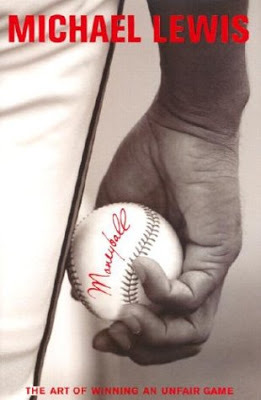
I learned a long time ago that in order to avoid arguments and lost friends, one should refrain from discussing three subjects: religion, politics and Moneyball. But since some very smart people I know recently brought up Moneyball as part of their baseball book club, I decided to read it again. And now that 13 years have elapsed since it's release, maybe this is a good time to look back and attempt to judge dispassionately whether or not it was correct in all it's establishment-shaking claims.
At this point I should disclose in all fairness that I did not particularly like Moneyball when I first read it. It made me mad. It challenged a lot of beliefs I had held dearly, number one being that I knew everything I needed to know about baseball and what was important in winning a baseball game. In general, people do not appreciate beliefs such as these being challenged; especially not by a bunch of smart-looking Ivy League nerds with computer printouts claiming to support their positions.
Yet, when I wanted to reread the book, I knew exactly where to find it. There is a small shelf at my house on which you will find Ball Four, The Boys of Summer, Leigh Montville's Ted Williams book, The Glory of Their Times and a few other books of similar stature. This is where I went to retrieve my copy of Moneyball; where it has rested undisturbed for 13 years. After reading it once more I realized why I had immediately recognized where it belonged and placed it there--it's that good of a book. Damn it. I didn't want it to be. I hoped it wouldn't be. But there's no denying; it was.
But conceding that the book is highly entertaining and well-written, several questions remain. Does Moneyball actually work? Is Billy Beane and his computer able to find quality, inexpensive future major league players in the draft better than the old scouts of the days of yore? What became of the men and the ideas upon which the book was based? Were the basic tenets espoused in the book concerning which statistics are most important correct? Will computer-wielding nerds entirely replace baseball-savvy veterans who actually played the game? Is Billy Beane really a genius and, perhaps most importantly, does he still look like Brad Pitt? These are the sorts of questions we can now use 13 years of enlightenment to try to answer.
We can assess the first question fairly easily by looking at the good-old fashioned black-and-white numbers of wins and losses. Since Billy Beane took over the A's in 1998, they are 1621-1455 (52.70%), a very respectable number for any team. When compared to other small market teams, none of which have come close to breaking even, the results are stark. Over this period, the Twins are 1497-1580 (48.65%), the Reds 1489-1590 (48.36%), the Brewers 1442-1634 (46.88%), the Pirates 1394-1679 (45.36%) and the Royals 1369-1707 (44.51%).
Over this period the A's have had 8 seasons of 90 or more wins, the Twins 5, the Reds 4. Obviously something is working here. For nearly two decades, Billy Beane has helped the notoriously shallow-pocketed, penny-pinching A's outperform every other small market team, and also a lot of large market ones, by a considerable margin of regular-season wins.
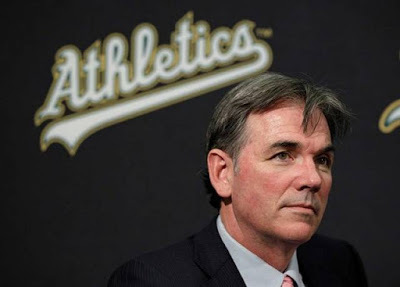
More impressive about Beane's results is the fact that he has maintained his success for almost two decades--long after his secrets got out. The Moneyball of 2016 is not the Moneyball of 2002. Sports executives are some of the biggest sponges known to man. Other smart teams, teams with much deeper pockets, found out about Beane's methods (especially after the book spilled the beans) and so the things he prized were no longer undervalued, and many became so overvalued by the market that he could no longer afford them. He has been forced to continually look for other sources of market-undervalued traits with which to win ballgames. Yet he has consistently been able to stay ahead of the curve (and the slider, the fastball and the change up).
The Moneyball A's made the postseason 8 times in 19 seasons; far more than any other small market team (Twins 4, Reds and Pirates 3, Brewers and Royals 2). Unfortunately, this is where the wheels fall off the Billy Beane Magic Show. The A's have ended their season with a loss in all 8 of those postseason forays and, in fact, have won only a solitary postseason series, sweeping the small-market Twins in 3 games in the LDS in 2006. In compiling a 1-8 record in postseason series, the A's have won a total of 15 games and lost 23. A maddening 6 times they have lost series 2-3--dropping the pivotal 5th game.
In the book Beane readily admits, "My shit doesn't work in the playoffs; my job is to get us to the playoffs. What happens after that is . . . luck." We should not allow Beane to cop a plea and get away with this generic blanket mea culpa for postseason failure, however. Especially we should not be so quick to accept the excuse of being on the wrong side of pure luck. Once, twice, maybe. But 8 times? Someone is in serious need of a rabbit's foot. Beane's "shit" certainly has proven itself over the course of 19 major league seasons. What's different in the postseason? Apparently a lot.
There are hints in the book. A's half-season rental speedster Ray Durham says, "Cautious doesn't work in the playoffs." A's coach Thad Bosley states, "If you say base running isn't important, you forget how to run the bases." Many feel that in the playoffs, when faced with other playoff teams' aces, there is a need to manufacture runs, using speed and occasionally bunting--the small ball that Beane disdains so fervently as a counterproductive waste of important outs. As of 2002, Beane felt that speed and defense were particularly overvalued by the market and, thus, unavailable to his shallow pockets. The past two years we have watched as the small-market Royals continually use small ball tactics, along with superlative defense, to win game after game in the postseason.
The book admits that the trade-off for obtaining players cheaply is that each has a flaw. And anyone who has ever tried to manage a Little League team understands that if you have a flawed player on the field, eventually the flaw will show itself; and often at inopportune times. In a short series against a good team, flaws become magnified.
Perhaps the problem with the postseason for Moneyball teams is that inevitably they run into teams that do not have obviously flawed players. They run into great teams that were put together without an eye on money, who have retooled late in the year to repair deficiencies. In short, just the kind of team that Billy Beane has never been able to field. Besides the impressive runs by the Royals the past two years, the other small-market teams have been similarly man-handled in the postseason (the Twins, Reds, Brewers and Pirates are 17-37 overall in postseason games and 2-9 in series).
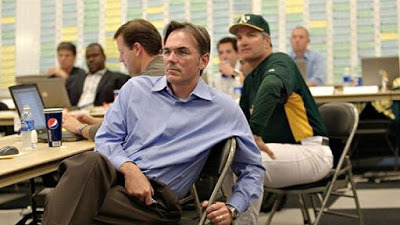
How about the draft? The book goes into great detail covering the excitement of the 2002 draft and makes many claims supporting the revolution Beane and his computer team were about to unleash by their ability to sniff out signable, undervalued specimens in the amateur baseball world. Their new methods were supposed to be particularly superior to that of traditional scouts who, invariably, allowed their past experiences and personal biases to interfere with what should be a cold, dispassionate evaluation. In short, scouts tended to rely more on the visual perception of a prospect's "tools" and their pipe-dream projection of what these tools may produce in the future rather than the indisputable truths of the numbers produced in amateur competition.
Every fantasy league player understands that professional sports drafts are a risk-laden endeavor. And the major league baseball draft is much less reliable than that of any other major sport. A man with Beane's budget cannot afford to pay above-market money for unpredictable talent in the draft. But has Beane and his computer actually enjoyed more success in the draft since 2002? In a word: nada, nien, nyet, nicht so gut. Or in plain English: not even close.
First, Beane's draft strategy. He was adamant in his belief that it was folly to draft high school players, particularly pitchers, because no one knew what they would become in four years. That may or may not be a valid strategy, but it does seem reasonable not to pay overpriced agent's wages to high school phenoms. Of course there are exceptions, such as Bryce Harper, Mike Trout, Ken Griffey, Jr., Joe Mauer, Chipper Jones, A Rod. . .
In general, Beane has stuck to his guns on this thought, rarely taking high school players anywhere in the draft. Inexplicably in 2005 six of the first nine Oakland picks were high schoolers. As if to emphasize the craziness in this, only two ever made a major league roster, and neither had any impact. Thereafter, Beane has stayed with college players but his draft results have been uniformly dismal.
Since 2002, the only Beane draft picks who have gone on to quality major league careers have been Andre Ethier, a second rounder in 2003 (who Beane traded 2 years later for Milton Bradley), Kurt Suzuki, a second round pick in 2004, and Huston Street, a first-rounder in 2005. There have been a few others who went on to short mediocre major league stents, however none were impact players. In order from 2003 to 2010, the A's first picks were: Bradley Sullivan, Bryan Snyder, Richie Robnett, Landon Powell, Clifton Pennington, James Simmons, Jemile Weeks, Grant Green and Michael Choice. If you ask, "Who?" you're not alone.
In 2012, Beane did astutely pick a high school shortstop, Addison Russell, but apparently undervalued him and traded him to the Cubs for half-season rentals Jason Hammel and Jeff Samardzija in July, 2014. Russell appears to be a fixture for the Cubs now.
We should give Beane a little wiggle room with the reasoning that, due to very limited resources, he is probably not able to sign the first round studs who employ the likes of Scott Boras. He has to look for players who not only may make the majors some day, but have a flaw that makes them signable by his team. Unfortunately for Beane, modern agents are very good at identifying any kid with the potential to be a major leaguer and surrounding them with a Beane-proof protective shell of unreasonable salary demands. This has led Beane to getting essentially nothing in the draft for a decade. At the same time, from 2004-2011, the small market Pirates were able to select and sign Neil Walker, Andrew McCutchen, Pedro Alvarez and Gerrit Cole. The Reds got Homer Bailey, Jay Bruce, Devin Mesoraco, Todd Frazier and Mike Leake and the Royals copped Billy Butler, Alex Gordon, Luke Hochevar and Eric Hosmer. Quality major leaguers all.
We can conclude that Billy Beane has not proven to be able to use his stats and computers to select affordable future major league players any better than the old scouts with which he held so much disdain. Beane's draft picks appear to have been born more of buffalo chips than computer chips. Apparently there is still a place for the grizzled old, tobacco-spitting, cliche-spewing human scout.
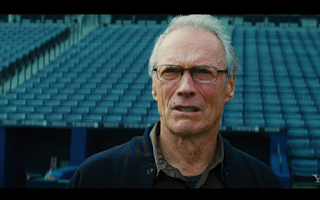
The book discusses a number of players and executives. It is interesting to look back at some of the prominent personalities and see what became of them:
Jeremy Bonderman was a good-looking high school pitcher whose selection in the first round of the 2001 draft by the A's head of scouting Grady Fuson caused Beane to demolish a chair and spew obscenities and. since he couldn't order his summary execution, fire Fuson not long afterwards. Bonderman, not valued by Beane, was soon dumped to Detroit, but became a member of a major league starting rotation with the Tigers by age 20 in 2003, when he went 6-19 for a very bad Detroit team. He had a nine-year career as a major leaguer, finishing 69-81 with a 4.91 ERA. His best year was 14-8 in 2006. Not bad and certainly better than a lot of Beane's picks over the next decade
Nick Swisher, Beane's prize first pick of the 2002 draft had a very solid, 12-year major league career, retiring after 2015 with 245 home runs, 803 RBIs and a career on-base percentage of .351.
Jeremy Brown, the fat college catcher with the great on-base percentage stats that Beane took in the first round bonanza of the 2002 draft, played six seasons in the A's minor league system and produced pretty much as advertised: a career .268 batting average with 288 walks in the six years, and a .370 OBP. He made it to the show for five games in 2006, going 3-for-10 with a walk. Despite this he was never deemed appropriate for the bigs, possibly because the green A's uniform made him look like a bat-wielding avocado. He retired after the 2007 season.
Pitcher Joe Blanton, taken in the first round in 2002, is in his 12th major league season and has been a very reliable, if not spectacular pitcher over that time. When last seen, he was still flinging in the 2016 postseason for the Dodgers.
Mark Teahen, also taken in the prized 2002 draft, was soon traded by the A's but went on to a fair seven-year major league career, spending 5 as a starter on some bad Royals teams as a third baseman and outfielder. His best season produced a .290 average with 18 home runs and 69 RBIs.
Brant Colamarino, the University of Pittsburgh outfielder who Billy's computer said was the best hitter in the entire 2002 draft, fell to the A's in the late rounds, possibly due to his less-than-svelte appearance. When he showed up in the A's locker room, his full-figured bare chest prompted a discussion of whether a male brassiere should be called a "manzier" or a "bro." Colamarino had some good hitting years in the minors but never made it to the majors. He retired after 6 minor league seasons with a career .273 batting average and .350 OBP.
Chad Bradford, the retread submarine pitcher with confidence issues who Billy's computer said would do great if someone only gave him a chance, had four very good years for the A's as one of their top men out of the bullpen. When his performance and tenure caused the market price for his services to reach a million-and-a-half a year Billy did what he had to: he traded him for younger, less expensive talent. Bradford pitched well for several other teams and retired at 34 with a 12-year career ERA of 3.26 in 561 games.
Paul Depodesta, Beane's right-hand man with a computer, has had a mixed post-book career. In 2004 he parlayed his way-with-numbers into the general manager's job of the Dodgers and, using what he had learned, led them to the playoffs in his first season. In 2005 injuries and the loss of some high-priced talent caused them to fall to their worst record since 1992 and the impatient owner gave him the ax. Depodesta worked for the Padres from 2006-2008 and Mets from 2010-2016 with mild degrees of mediocre success and then, in a stunning crossover to the dark side, was hired by the football Cleveland Browns as chief strategy officer in January of 2016. Most amateurs realize that the chief strategy for the Browns should be something along the lines of getting a decent quarterback who is more mature than a 12-year-old and performs better on the football field than in sorority houses and, once they have found the guy, to maybe to stick with him for more than one season. Unfortunately, tradition and all human logic dictate that Depodesta is destined to fail spectacularly in Cleveland.
Kevin Youkilis (aka the Greek God of Walks), was the young player in the Red Sox system coveted so dearly by Billy Beane's computer. The A's were never able to pry him loose, mainly because a young nerd in the Boston office, Theo Epstein, was paying attention to what Beane was doing and continually parried his overtures. Youkilis had a very good major league career and helped to end the curse of the Bambino, playing a minor role in the Red Sox World Championship in 2004 and a major one in 2007.
Scott Hatteberg was the sore-armed ex-catcher whose tendency to draw walks made him so valued by Beane that he converted him into a first baseman. Hatteberg gave Beane four solid seasons of well-above average OBP as a first baseman with no power, then was released and signed with Cincinnati as a free agent. Playing until he was 38 years old, he had two more solid seasons for the Reds.
A's infield coach Ron Washington, whose patience and folksy wisdom helped Scott Hatteberg's psyche as he adjusted to the demands of first base, left to manage the Texas Rangers in 2007. He took them to back-to-back World Series in 2010 and 2011.
J.P. Ricciardi, A's director of player development, was hired away by the Blue Jays to work his Moneyball magic as their general manager in 2001. He remained in that post until 2009, having the modest success of a few .500 teams but never made the playoffs.
Theo Epstein, mentioned briefly in the book as a young Yale graduate recently hired by the Red Sox who aspired to be the next Billy Beane, was promoted to GM by the new Boston owner after the 2002 season and quickly proved to be a forward thinker. He indeed became a Billy Beane, albeit one with money--a scary thought. After leading the Red Sox to the promised land in 2004 and 2007, Epstein jumped to another well-endowed reclamation project, the Chicago Cubs, and immediately positioned them to break another longstanding curse, this one a bit more than a century.
A large part of Moneyball, dealt with numbers; mainly the use of numbers and formulas to try to find and exploit inefficiencies in the market and thus to help win ball games. Some of the claims attached to these numbers were the major source of emotional gnashing of teeth caused by the book: the ones that attacked several long-held beliefs by the baseball establishment. How do they look 13 years down the road?
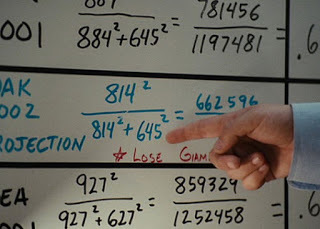
The book helped immensely to popularize the importance of two previously underappreciated offensive categories: on-base percentage and slugging percentage. While SABRites had been touting these for years, Moneyball helped move them in to everyday vernacular, alongside other more traditional stats. It was relatively controversial when the book advocated that OPS, on-base percentage plus slugging percentage, was one of the most accurate assessments of offensive performance, much more important than things like RBIs and batting average.
I admit that I am never the first to embrace new formulas and stats. The old ones were popular for a reason. I have a simple test, a baseball litmus test if you will, that I apply anytime a new formula is proposed. I call it the Babe test. Simply explained, any method that does not result in Babe Ruth being ranked as the most devastatingly efficient baseball player of all time is completely flawed. And it turns out that OPS ranks the Bambino firmly atop all major league players in history. Test passed: that's enough for me. And apparently everyone else. Today, most baseball discussions include OBP and OPS.
Another concept the book asserts, that I strongly agree with, but apparently some general managers still do not, is that plate discipline can not be taught and a strike out is the most expensive thing a batter can do. For over a century, baseball scouts have looked for certain tools and rationalized that hitting can be taught. This explains to Reds fans who watched helplessly as Drew Stubbs, a former first round, five-tool player, was presented with the center field job, based solely on the appearance of those five tools. He proceeded to strike out as much as 205 times a year and had an OBP of .277, yet was allowed to continue to play everyday for 3 long years, much to the detriment of his team. The appearance of talent does not necessarily mean a guy will be a good ballplayer who will help his team win. And a guy with no plate discipline who strikes out a lot will most likely continue to do so. Millions of dollars and countless games continue to be lost for failure to realize this.
The middle of the book is almost as much about Bill James and his cohorts as Billy Beane. Bill James has certainly brought a large amount of information to the baseball world and is in a class of his own in this regard. But there are a few things I disagree with. One is the disparaging remarks about the box score and the assault on batting average as a measure of a hitter. I happen to think the box score, while admittedly containing minor flaws, was one of the great inventions of the 19th century. Thousands of kids like me grew up racing to the paper each morning to inhale the previous day's box scores.
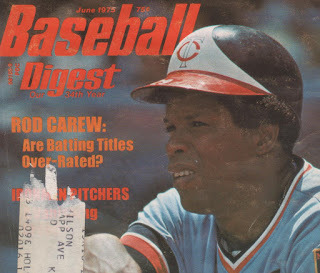
The questioning of batting average is not a new thought. It's been more than a century since the Chalmer company stopped giving out cars to the batting leader. I recall an article in Baseball Digest from the 1970s about Rod Carew asking if leading the league in batting average was not overrated. I will concede that there are other more important factors, particularly OPS as mentioned above. But I maintain that batting average is still very important. And I totally disagree with the "luck" factor. The book quotes Bill James as saying "one absolutely cannot tell, by watching, the difference between a .300 hitter and a .275. The difference is one hit every two weeks." That to me is a gross oversimplification of numbers, the same argument put forth much more eloquently by Crash Davis in Bull Durham. There is a great difference between a .300 hitter and a .275 hitter and it strains the mind to think someone would not intuitively understand that it is about much more than 13 extra hits every 500 at bats.
Mickey Mantle was a .300 hitter, Hank Aaron was a .300 hitter. Pete Rose and Willie Mays were .300 hitters. Rich Aurilla, Corey Kloskie, Shane Victorino and Marlon Byrd were .275 hitters. Can anyone tell me they can't tell the difference, just by watching, and by watching the reaction of others, when the first four walked to the plate compared to the latter four? Yes, this is a gut answer and other examples can be found to support the opposite opinion. Occasionally a lousy hitter will have one year in which the gods smile on him and every seeing eye bleeder leaks through, every off-the-handle-bloop falls in and at the end of the season his average is over .300. But hitting .300 remains one of the toughest things to do in sports and only a very few men can do it consistently; and these are almost uniformly very good hitters. So I can assure you, there is a big difference between a .300 hitter and a .275 one.
The book brings up luck as an important factor once a ball is put in play in determining whether an out, an error or a hit results. It definitely is for certain situations. And there are ballpark factors and defensive shifts and overall opponent-defensive skill involved as well. But the force of how hard and cleanly a ball is struck determines much more than luck and over 500 or 5000 at bats the difference due to luck becomes negligible.
And the mention of luck brings up another point of violent disagreement I have with the book: that clutch hitting is either a fantasy or an ancient religion that has no relevance to modern man. The book states this several times, backed by the opinion of various SABRites who espouse that luck, rather than clutch playing, is the only determinant in tight situations. This may feel true when someone who never looked out at a pitcher from 60 feet, six inches while everyone in the park was on their feet screaming stares at a computer simulation of a game or an unemotional sheet of stats. But I can't believe that anyone who ever played the game, even in Little League, can look back and not believe that certain guys just seem to perform better in tight situations.
Maybe the nerds don't like this because no one has found a way, despite numerous attempts, to completely take emotion, fans, situation and the need-to-produce-right-now-in-order-to-win and reduce it to a reproducible cold statistic for analysis. Each situation is different. Sometimes the most clutch situation occurs in the 5th inning, not the 9th. Sometimes a truly clutch situation doesn't pop up for weeks. Sometimes it inadvertently presents after an over-thrown cut-off as the ball is rolling innocently through the infield. Luck may describe one-time or short-term events, such as Brian Doyle, Gene Larkin, Rick Dempsey or even Bill Mazeroski. But anyone attempting to ascribe what Babe Ruth, Bob Gibson, Mickey Mantle and Reggie Jackson did all those Octobers to plain luck possesses a severe lack of understanding of human nature and the game of baseball.
I admit this is a completely irrational opinion with no proof to back it up. But I would like to state further that if, by chance, someone finally does come up with a true analysis disproving clutch, I don't want to know about it. Part of the magic of the game is that it is played by human beings, subject to the trials, triumphs and tragedies that humans go through. I want to continue to believe in the nebulous concept of great men, or even very rarely not-so-great men, rising to the occasion. What's next for these nerds: will they enter a kindergarden with a handful of computer stats to prove conclusively to the kids that Santa can't possibly get around the earth in one night? Do we really want to know that?
Um, excuse me. I apologize for the emotional digression--and this is exactly why we should refrain from discussing Moneyball in polite company. It is impossible to remain rational and composed.
Back to the realm of the concrete. To summarize:
Does Moneyball work? Remember it was proposed as a way for a financially-handicapped team to compete in an unfair world, not as the ultimate guide for winning. That being said, it is not the only way to win, but one way that has certainly proved its worth.
Are nerds taking over? They definitely have their place. Ignore them at your own peril. But there is still a place for the traditional old-timer as well.
Is Billy Beane a genius? Maybe--he has won many more games than anyone else leading a small-market team. And has done so repeatedly for almost two decades.
Does Billy Beane still look like Brad Pitt? No. He never did. Actually he looks more like a young, fit Billy Bob Thornton if anything. I wonder why they didn't get Billy Bob for the movie?
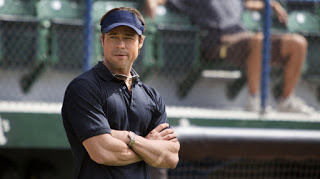
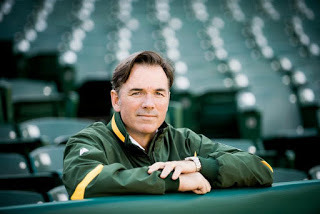
Published on October 22, 2016 09:24
October 13, 2016
Where Do the Ducks Go in the Winter? Ode to a Little League Coach

"You know those ducks in that lagoon right near Central Park South? . . . By any chance, do you happen to know where they go, the ducks, when it gets all frozen over? . . . I mean does somebody come around in a truck or something and take them away, or do they fly away by themselves – go south or something?"-----Holden Caulfield, Catcher in the Rye
Everyone called him Duck. I never knew, and never thought to ask, what his real first or last name was. But for three summers he was the most important adult in the life of this almost-pathologically-shy, baseball-crazed runt. I don't recall ever saying a single word to Duck and I doubt that Duck ever appreciated the great power he held in his hands--to influence my playing time, experience and, most-importantly, my budding self-image. But he couldn't have been better.
I'm not sure how old Duck was when I first met him. The memory provided to me by my then-ten-year-old eyes is that he was ancient. And looking at the team picture from 1971, standing at the far right, he certainly had already seen considerable mileage.
Our league back then was peculiar; there were almost no dads coaching. In that regard, Duck was not unusual for the time. So we never thought it strange that an old guy like Duck was our coach even though he had no kids on the team. Looking back, I'm sure he was just someone who loved the game, enjoyed being around it and, maybe, wanted to pass on some of his knowledge.
Someone said that Duck had once played some minor league baseball but he never confirmed nor denied it. I don't recall him ever starting a sentence with, "Once I did . . . " There were no hoaky old war stories from the baseball fields of his past. He was content to leave his past exploits to mystery.
But there was no doubt in our minds that he had once played considerable baseball; and seriously. For one thing, he sounded like a ballplayer. He knew all the words of the arcane and important language of the dugout. He was forever talking about Texas Leaguers, cans of corn and the ever-elusive Baltimore Chop. He frequently reminded our pitchers to "Rock and fire, babe. Rock and fire," even though, alas, our pitchers could do nothing that resembled firing and probably had no idea how to rock. But we all knew that while pitching it was important to rock and fire because Duck said it.
When we showed up early to practice, Duck would always organize us to "play a little pepper" until the other kids showed up. Apparently, a fact known only to the most experienced baseball players, pepper was a magical game, but very potent; a little was all you needed. It was always "a little pepper." For some reason we couldn't understand, only an inexperienced fool would ever dare to try to play a lot of pepper.
While we were batting in games, Duck was always exhorting the hitter to "Pick you one out. How 'bout a little bingle." And that was another great thing about Duck. Other coaches may have badgered their players, demanding doubles or triples or even home runs. Not Duck. Duck was perfectly content with only a bingle. And a small one at that.
Duck seemingly always had a big chaw of tobacco in his jaw. Because, we reasoned, that's what real big leaguers did--we saw that much on the Saturday Game of the Week on our grainy black and white TVs. But this was a time in which tobacco was not second to only arsenic as a vehicle of instant death. I clearly recall watching other coaches hit infield grounders to their teams with a cigarette dangling expertly and casually from the side of their mouths (this was the early '70s remember).
But the biggest proof my memory provides that Duck had once played ball is the mammoth fly balls he would launch sometimes at the conclusion of practice, if we begged him enough. We often practiced on the high school football field adjacent to the worn Little League field, so that provides somewhat of a reference. I remember, although the cloud of 45 years could obscure the exact distance slightly, the balls traveling the entire 100 yards of the field. What is not obscured in any way, however, is the jaw-slacking awe with which we watched those majestic--dare we say Ruthian--swats. I was proud to be one of the brave, and perhaps recklessly foolhardy, souls who tried to catch those lethal projectiles.
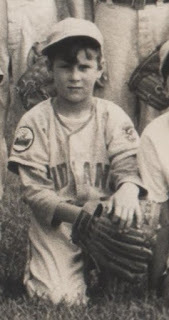
I wasn't much to look at as far as an athletic specimen. I had always been the smallest kid in every class in school. But Duck saw something in me. I like to think that it was a little bit of talent and promise; but maybe it was just a kid who kept his mouth shut and tried to do what the coach told him in the midst of other half-crazed kids running in all directions. Whatever the reason, I have almost no recollection of any time spent on the bench, even as a 10-year old in the 10-12 league.
Sometimes Duck stayed after practice to throw me extra batting practice, which I lapped up like a starved pup. I would hit and hit until dark forced our sessions to end. And while doing so, I noticed that I could make a bat meet a thrown ball better than even most of the big kids.
I remember how proud I felt early that first year when I got one of our only hits against the Reds' Billy May. Billy was a hulking 12-year-old who was our town's closest imitation of Mickey Mantle. A mere two years later Billy would start in center field for the local high school varsity as a freshman. On this day, he was simply overpowering. After listening to the older kids returning to the dugout speaking in fear and awe of Billy's heater, I walked to the plate wielding my trusty wooden flame-tempered, 28-inch, Tony Oliva model bat and dribbled a double down the third base line.
Once when we at long last possessed a lead late in a game that first year, someone on the bench mentioned that it was tradition that Duck always sprung for milkshakes at the nearby Tasty Freeze after every victory. And when we held on to win and piled over to the Tasty Freeze in a mass of whooping excitement, he did.
Whether due to their relatively cheap cost in those days or due to the lack of overall talent on our teams, Duck never went broke paying for milkshakes. But, remarkably, he didn't seem to mind. I never remember Duck yelling at, or even questioning an umpire. And I'm pretty sure our umpires were not perfect. I don't remember Duck yelling at any of his players either, despite the fact that there were those on our team who were known to commit an error or two. Maybe it was because Duck was satisfied with what he had accomplished on a baseball field when he was young--he didn't need to prove anything to anybody by the proxy of Little League kids. Or maybe he really just didn't care about winning. But I like to think it was the former.
As I look back, I think Duck was the perfect coach for my personality and temperament at the time. He let us play the game, learn to win and lose, succeed and fail, and have fun, while providing guidance but not too much interference.
One of the proudest moments of my life, which provoked a completely surprising and unexplained lump in my throat and a tear in my eye, came when I answered the phone one day late in my last season and listened as Duck excitedly broke the news that I had been selected to the All-Star team.
That summer was perhaps one of the best I would ever have on any athletic field. Unfortunately for me, that would be my last year of relative equal competition. Very soon a testosterone-fueled arms-race would erupt and I would be the last to know. After the season, seemingly everyone else went home and hit puberty. And none of the sons-of-bitches bothered to tell me what they were up to.
The next year, a summer in which I was struggling with the impossible task of trying to compete with the behemoths of the 13-to-15-year-old Babe Ruth League, I was uplifted immeasurably when one of my former teammates told me that Duck had used me as an example while talking to the team one day. He had said, "We had this dude named Wilson last year. Never said a word. Just went out and did his thing . . ." Words cannot explain how proud I felt that Duck had not only remembered me, but held me up to his future players.
I never again saw Duck after that year. He had to have been at least sixty back then; you can do the math. I hope he had a long and happy life filled with countless little bingles.
Where have all the Ducks gone, in these past decades of winter? Kids don't have coaches like Duck anymore. That's sad. And unfortunate.
But I was lucky.
So here's to Duck.
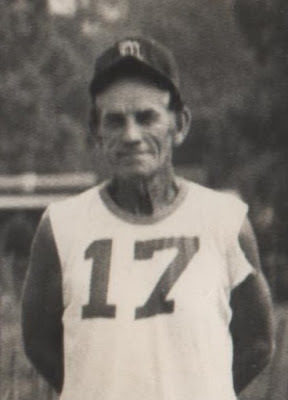 He was the best.
He was the best.
Published on October 13, 2016 10:23
October 10, 2016
The Vacuum Cleaner: 46 Years Ago This Week Brooks Robinson Treated the Nation to a Week of Great Plays
And it all started in the first game:
It was the bottom of the sixth inning of the first game of the 1970 World Series. The powerful Big Red Machine was tied with the Baltimore Orioles, 5-5. Lee May, the Cincinnati first baseman, took his place in the right-handed batter’s box. A strapping man known as a dead pull hitter, May had hit 73 home runs in the past two seasons. He focused intently on the pitcher, Jim Palmer, and paid no attention to the man standing roughly 100 feet to his left. That man, Baltimore third baseman Brooks Robinson, was studying him closely however. A thirty-three-year-old veteran with droopy shoulders, a doughy body and a rapidly receding hair line, Robinson did not look like a professional athlete when seen out of uniform; but looks could be deceiving. Robinson held his hands close together in front of his chest and crouched, not unlike a cat before pouncing on a mouse. On his left hand he wore an ordinary-looking piece of leather that held the words “Rawlings Pro Model.” The glove was stained brown, stiff and cracked. The fur under the wrist strap was worn and frayed. This glove was not the only glove Robinson possessed. He had two other gloves in his locker that he used during pre-game practice to break in for future use. He also had some gold ones at home—he had been the winner of the past eleven Gold Gloves for American League third basemen. Brooks Robinson had been one of the best players in baseball over the previous decade and was appearing in his third World Series in five years but, in the days before daily television highlights, he was still somewhat underappreciated by casual fans outside Baltimore. That was about to change. As Palmer went into his long-armed windup, Robinson did not realize that the next pitch would be the start of a series of events over the next five days that would ensure that the unappealing piece of leather on his hand would wind up in the Baseball Hall of Fame a good ten years before its owner would. Palmer threw an off-speed pitch that hung a bit more than he would have liked. May kept his weight back, and then unleashed a vicious swing that met the ball squarely, sending it rocketing down the third base line. May, as all baseball players are taught on similarly hit balls, was thinking two bases as he left the batter’s box. The ball took two bounding hops off the artificial turf—1970 artificial turf that was little more than green carpet laid on concrete—and shot over third base like a golf ball skimming over an airport runway.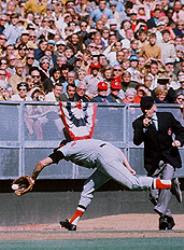 From his original position ten feet off the line, on the back edge of the infield, Robinson took four quick steps and lunged to his right, reaching as far as possible with his gloved left hand. He back-handed the ball behind third base, spearing it just as the umpire on the edge of the outfield waved his hand indicating that it was a fair ball--a great snag that would hold May to a single.
From his original position ten feet off the line, on the back edge of the infield, Robinson took four quick steps and lunged to his right, reaching as far as possible with his gloved left hand. He back-handed the ball behind third base, spearing it just as the umpire on the edge of the outfield waved his hand indicating that it was a fair ball--a great snag that would hold May to a single.
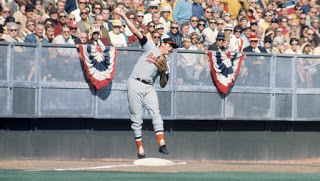
But Robinson wasn’t finished. He took one more step with his left foot and, with his back to the infield and his momentum carrying him well into foul ground, turned in midair and, throwing across his body, seemingly without looking, launched the ball in the general direction of the Ohio River.
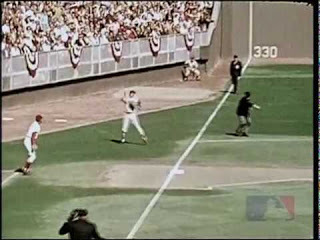 Incredibly, the ball arrived to first base on one hop just before May did. The first base umpire jerked his closed fist into the air and fifty thousand fans watching the game in the stadium and millions more watching on television gasped at what they had just witnessed.
Incredibly, the ball arrived to first base on one hop just before May did. The first base umpire jerked his closed fist into the air and fifty thousand fans watching the game in the stadium and millions more watching on television gasped at what they had just witnessed.
This one play, which would come to be regarded as one of the top fielding plays in World Series history, was only a preview to the next four games. The Reds would be continually flummoxed in attempts to drive the ball through the left side of the Orioles’ infield, stopped by an endless series of unbelievable plays by Robinson.
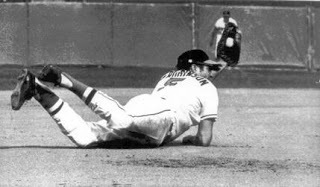
By the end of the week, Brooks Robinson would be the most celebrated fielder in baseball history. He would be selected as the Most Valuable Player of the World Series, and the fact that he hit .429 with two home runs and six RBIs was almost superfluous.
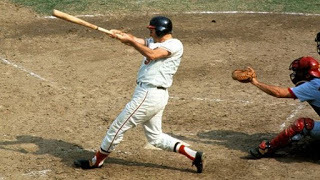
It was more than just the most dominating performance of an entire World Series by a single player, it was transcendent; sublime. Even Reds fans, who hated what he did to their team, had to admire the sheer artistry of it all. Amazingly, after the Series the Orioles players and coaches acted like they didn’t know what all the fuss was about. They said they had been watching the same thing for years and these weren’t even his best plays. And the thing about it was, they were telling the truth.
Brooks Robinson would go on to complete a 23-year major league baseball career, all with the Orioles, and would join his glove in the Baseball Hall of Fame in 1983.
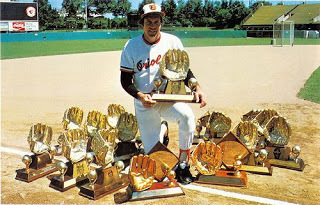 He would participate in eighteen All-Star games, accumulate a record sixteen consecutive Gold Gloves, set records for fielding percentage and be selected to the All-Century Team.
He would participate in eighteen All-Star games, accumulate a record sixteen consecutive Gold Gloves, set records for fielding percentage and be selected to the All-Century Team.
As great as he was on the baseball field, however, the singular way in which Brooks Robinson conducted himself off the field would be as important as anything he did on it. He was universally acknowledged as baseball’s nice guy; a man friendly to writers, fans and opposing players; a man who always demonstrated class and regard for others. Forty years after he played his last game, Brooks Robinson remains an unquestioned icon in Baltimore. His genuine, humble demeanor, friendliness, and above-all, ability to remain a great role model, has somehow grown in significance over the years as fans are continually disappointed by sports figures who are rude, selfish and inaccessible. Brooks Robinson exhibits the exact opposite of all the traits that modern fans hate in their sports idols. And, no matter how much fame and adoration he achieved, he never lost the sense of who he was: just a regular guy who loved the game of baseball. It was his great character, rather than his athletic ability, that prompted a writer to remark, “Brooks Robinson never had a candy bar named after him. In Baltimore, people name their children after him.”
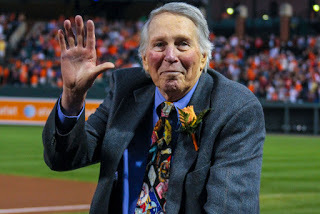
It was the bottom of the sixth inning of the first game of the 1970 World Series. The powerful Big Red Machine was tied with the Baltimore Orioles, 5-5. Lee May, the Cincinnati first baseman, took his place in the right-handed batter’s box. A strapping man known as a dead pull hitter, May had hit 73 home runs in the past two seasons. He focused intently on the pitcher, Jim Palmer, and paid no attention to the man standing roughly 100 feet to his left. That man, Baltimore third baseman Brooks Robinson, was studying him closely however. A thirty-three-year-old veteran with droopy shoulders, a doughy body and a rapidly receding hair line, Robinson did not look like a professional athlete when seen out of uniform; but looks could be deceiving. Robinson held his hands close together in front of his chest and crouched, not unlike a cat before pouncing on a mouse. On his left hand he wore an ordinary-looking piece of leather that held the words “Rawlings Pro Model.” The glove was stained brown, stiff and cracked. The fur under the wrist strap was worn and frayed. This glove was not the only glove Robinson possessed. He had two other gloves in his locker that he used during pre-game practice to break in for future use. He also had some gold ones at home—he had been the winner of the past eleven Gold Gloves for American League third basemen. Brooks Robinson had been one of the best players in baseball over the previous decade and was appearing in his third World Series in five years but, in the days before daily television highlights, he was still somewhat underappreciated by casual fans outside Baltimore. That was about to change. As Palmer went into his long-armed windup, Robinson did not realize that the next pitch would be the start of a series of events over the next five days that would ensure that the unappealing piece of leather on his hand would wind up in the Baseball Hall of Fame a good ten years before its owner would. Palmer threw an off-speed pitch that hung a bit more than he would have liked. May kept his weight back, and then unleashed a vicious swing that met the ball squarely, sending it rocketing down the third base line. May, as all baseball players are taught on similarly hit balls, was thinking two bases as he left the batter’s box. The ball took two bounding hops off the artificial turf—1970 artificial turf that was little more than green carpet laid on concrete—and shot over third base like a golf ball skimming over an airport runway.
 From his original position ten feet off the line, on the back edge of the infield, Robinson took four quick steps and lunged to his right, reaching as far as possible with his gloved left hand. He back-handed the ball behind third base, spearing it just as the umpire on the edge of the outfield waved his hand indicating that it was a fair ball--a great snag that would hold May to a single.
From his original position ten feet off the line, on the back edge of the infield, Robinson took four quick steps and lunged to his right, reaching as far as possible with his gloved left hand. He back-handed the ball behind third base, spearing it just as the umpire on the edge of the outfield waved his hand indicating that it was a fair ball--a great snag that would hold May to a single.

But Robinson wasn’t finished. He took one more step with his left foot and, with his back to the infield and his momentum carrying him well into foul ground, turned in midair and, throwing across his body, seemingly without looking, launched the ball in the general direction of the Ohio River.
 Incredibly, the ball arrived to first base on one hop just before May did. The first base umpire jerked his closed fist into the air and fifty thousand fans watching the game in the stadium and millions more watching on television gasped at what they had just witnessed.
Incredibly, the ball arrived to first base on one hop just before May did. The first base umpire jerked his closed fist into the air and fifty thousand fans watching the game in the stadium and millions more watching on television gasped at what they had just witnessed.This one play, which would come to be regarded as one of the top fielding plays in World Series history, was only a preview to the next four games. The Reds would be continually flummoxed in attempts to drive the ball through the left side of the Orioles’ infield, stopped by an endless series of unbelievable plays by Robinson.

By the end of the week, Brooks Robinson would be the most celebrated fielder in baseball history. He would be selected as the Most Valuable Player of the World Series, and the fact that he hit .429 with two home runs and six RBIs was almost superfluous.

It was more than just the most dominating performance of an entire World Series by a single player, it was transcendent; sublime. Even Reds fans, who hated what he did to their team, had to admire the sheer artistry of it all. Amazingly, after the Series the Orioles players and coaches acted like they didn’t know what all the fuss was about. They said they had been watching the same thing for years and these weren’t even his best plays. And the thing about it was, they were telling the truth.
Brooks Robinson would go on to complete a 23-year major league baseball career, all with the Orioles, and would join his glove in the Baseball Hall of Fame in 1983.
 He would participate in eighteen All-Star games, accumulate a record sixteen consecutive Gold Gloves, set records for fielding percentage and be selected to the All-Century Team.
He would participate in eighteen All-Star games, accumulate a record sixteen consecutive Gold Gloves, set records for fielding percentage and be selected to the All-Century Team.As great as he was on the baseball field, however, the singular way in which Brooks Robinson conducted himself off the field would be as important as anything he did on it. He was universally acknowledged as baseball’s nice guy; a man friendly to writers, fans and opposing players; a man who always demonstrated class and regard for others. Forty years after he played his last game, Brooks Robinson remains an unquestioned icon in Baltimore. His genuine, humble demeanor, friendliness, and above-all, ability to remain a great role model, has somehow grown in significance over the years as fans are continually disappointed by sports figures who are rude, selfish and inaccessible. Brooks Robinson exhibits the exact opposite of all the traits that modern fans hate in their sports idols. And, no matter how much fame and adoration he achieved, he never lost the sense of who he was: just a regular guy who loved the game of baseball. It was his great character, rather than his athletic ability, that prompted a writer to remark, “Brooks Robinson never had a candy bar named after him. In Baltimore, people name their children after him.”

Published on October 10, 2016 10:55
October 3, 2016
When Larry Bird Played College Baseball
Quick, name the only man to ever win the Naismith College Basketball Player of the Year Award, three NBA MVP Awards and have a college baseball batting average of .500.
If you answered "Larry Bird," congratulations, you read the title of this article.
While most people know Bird accomplished the first two, many find the third somewhat surprising.
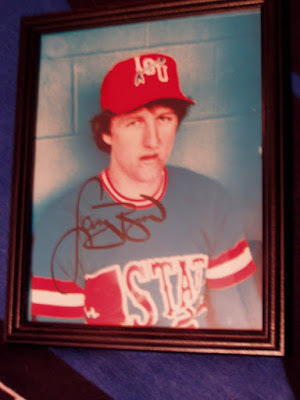
It's true but, in all fairness, a bit of explanation is in order.
First, some housekeeping business. Look up "Larry Bird" in baseball-reference and it says that he played one double-header of college baseball in the spring of 1979 against Western Kentucky. While I frequently use baseball-reference to fact-check things and have great respect for those guys, in this case they have made a colossal mistake: the games were not against Western Kentucky, a division I school from Bowling Green, but Kentucky Wesleyan, a division II school from Owensboro. I know that's a seemingly insignificant factoid for our story but it bothers me because I went to Kentucky Wesleyan, arriving there in the fall of 1979. I'll admit few people probably care about that mistake, except for me and a few other Wesleyan grads.
Back to the story: a long time ago, in the Jurassic period of American sports, before year-round commitments to under-6 soccer travel programs and shoe company-sponsored AAU basketball teams for elite 6th graders, athletes frequently enjoyed playing all sports and it was not uncommon for the best athletes to participate in more than one sport in school. Larry Bird had been a pretty fair baseball player as a kid. He played baseball in high school and he continued to play softball during the summers after high school. Even as he became the most heralded college basketball player in the country, dropping north of 30 points a game as a sophomore and junior at Indiana State, he and his brother played on a several softball teams that dominated local leagues and traveled throughout the midwest for tournaments in the summer.
The 6'9 Bird played outfield and first base in softball and had a good home run stroke. One source said he hit 12 home runs in 20 Terre Haute city-league games before his senior year. Softball was not without peril for a man who hoped to make a future living shooting basketballs, however. Bird seriously injured a finger during a softball game, either before his senior season or during the summer before starting in the NBA. He was playing left field and charged a sinking line drive. Some say he got his right hand in the mitt too soon, some say he dove and the right hand twisted under his tumbling body. Afterwards, the index finger on his right hand, his shooting hand, was forever misshapen and unbendable. Bird never said anything about the injury publicly, but Boston fans noticed the peculiar angle of the finger when he shot free throws and he later admitted that he was forced to rework his shot.
Check out the gnarly protrusion of the knuckle of his upraised index finger below:
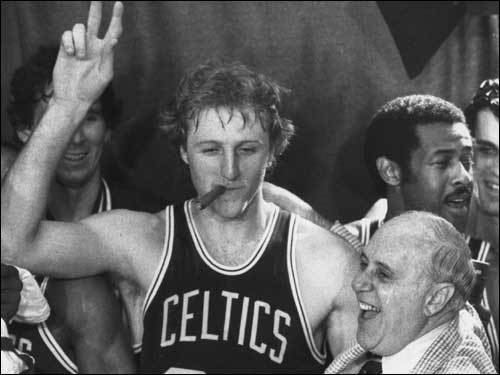
Bird loved baseball and, at the relatively small school of Indiana State, he was friends with most of the baseball players as well as the coach and regularly attended baseball games. One day as he was working out in the fieldhouse, the baseball coach, Bob Warn, passed and the two exchanged insults and laughs. One thing led to another and Warn challenged him: "You'd better get a bat." Bird answered, "Hey, I'll do it." A plan was hatched for Bird to join the baseball team for an upcoming doubleheader. Warn later admitted that his motivation was to increase interest and attendance for his team but that he also enjoyed having Bird around.
This was the spring of 1979, Bird's senior year. Bird had been selected by the Boston Celtics as the sixth pick of the 1978 NBA draft, eligible for the draft under the rules of the time because his original class had graduated (he lost a year due to transferring from Indiana) but he had decided to return to finish his college career.
In the spring of 1979, Bird and the Celtics were working intensely at hammering out a deal. The negotiations had stalemated and were becoming tense. Bird's agent, Bob Woolf, was requesting a 6-year deal for $6 million. The Celtics remained adamant that they wanted to pay only about $500,000 a year. The Celtics were well aware, however, that if he remained unsigned their claim to Bird would expire the minute the 1979 NBA draft commenced on June 25.
At the time, Bird was on top of the sporting world. He had just led his Indiana State team to a 33-0 record and the NCAA championship game in Salt Lake City before losing to Magic Johnson's Michigan State team in a game that ushered in a new era of popularity for basketball.
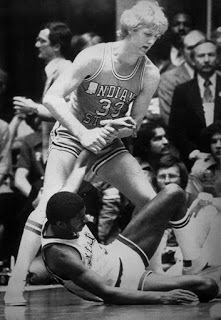
And his popularity in Indiana in the spring of 1979 can not be overstated. This was still the "Hoosiers" era in the basketball-crazed state--Indiana citizens held their collective breath each spring while the all-comers single-class high school tournament played out, making eternal legends of high school heroes like John Wooden, Oscar Robertson, Scott Skiles, Damon Bailey and, especially, Bobby Plump (the guy who made the last-second shot for the Milan Indians, aka Hickory Hoosiers, in 1954). It was also the hey-day of Bobby Knight at Indiana University. So when small-town Indiana star Larry Bird led Indiana State to the NCAA finals, well, it just couldn't get any bigger than that.
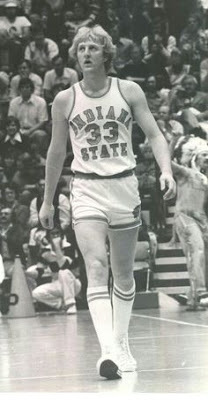
The Indiana State baseball team had a 23-6 record going into the day. Kentucky Wesleyan's mark was somewhat less impressive. Since as much myth as truth usually grows out of such events, I consulted several contemporary newspaper accounts as well as talked to a college friend, Mike Hayes, who played for Wesleyan that day.
The games were played on a cold, damp Saturday afternoon on April 28, 1979. An unwelcome breeze blew in off the west-Indiana farmlands and added extra chill to the players and fans. It had rained the day before and there were puddles down the lines and in the on-deck areas. But Larry Bird was scheduled to play, brightening the spirits of all present. Bird's participation in the baseball game had been heavily advertised and, as hoped, it drew a large and boisterous crowd. More than 2,000 fans showed up; infinitely more than the usual crowd of a few girlfriends, a few parents and, if it was a nice, sunny day, a couple of coeds hoping to work on their tans. Fans spilled out of the grossly inadequate bleachers and into the grass surrounding the field. Despite the weather, a circus-like atmosphere prevailed. Bird had been honored the night before with a banquet and there was little doubt about who the crowd had come to see.
When they realized Bird was not starting the first game, many in the crowd booed. But he soon entered the game, and baseball lore. Bird had been given the biggest uniform they had, but the team had never suited up a 6'9 guy before. The pants stretched to just below his knees. The jersey, also the largest available, was number 24, not the 33 he made famous on the hardwood. His curly Big Bird hair spilled from under the cap.
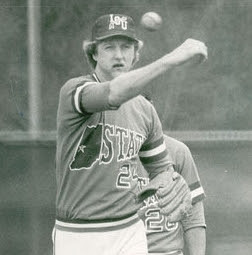
Bird played first base and struck out in his only at bat in the opener. Possessing an enormous strike zone and determined to take his hacks, he was easy prey the first time up, taking three technically-flawed swings and receiving a standing ovation while walking back to the dugout. In the Indiana State dugout, the regular first baseman turned to the coach and said, "I did that five times last week and nobody ever clapped for me."
"He definitely had a softball swing," Hayes remembers. "It looked almost like a straight uppercut."
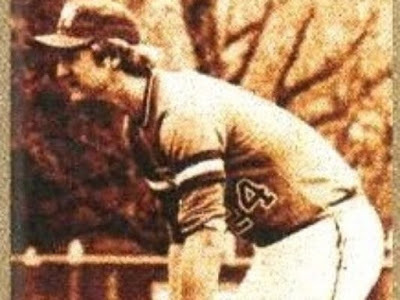
The large media presence irritated Bird, who did not want to take anything away from his temporary teammates. Coach Warn later told reporters that Bird was definitely not interested in playing the game as a show. "He plays the game just as he does basketball, with every ounce he has. He's very intense. He was remarking to one of the players before the game that he just wanted to do well; he didn't want to let the team down."
"Bird would go behind the dugout to get away from the photographers," says Hayes. "He was trying to act like it was just a normal game, but they kept trying to get into the dugout to take pictures."
Any chance the Wesleyan pitchers were tempted to take it easy on the famous Mr. Bird? "No way," says Hayes. "This was a real game to us. There's no way anyone would have let up on him. Besides, we all knew it would be a great thing to be able to tell your grandkids that you once struck out Larry Bird. And I don't think he would have wanted that either. He was completely serious. This was a real game to him too."
While Bird and other players might have tried to view it like any regular game, it was impossible for fans and opposing players to ignore the elephant in the room, or rather, on first base. "Pat O'Neil [who later coached nearby Brownsburg to several state titles sporting guys like Tucker Barnhart, Drew Storen and Lance Lynn] got on first and shook his hand," says Hayes. "Somebody in our dugout said, 'Why don't you kiss his butt too?'"
"But Bird was nice about it. He acted like a regular guy. I got on in the second game and when I was leading off and he was holding me on, we talked. He was friendly. We talked about the weather and stuff you usually shoot the breeze with any first basemen about."
Bird started the second game at first base. Batting with men on second and third and the Sycamores trailing 1-0, he bounced a ball into center field that brought home two runs. "It was about a 55-hopper up the middle that snaked through," says Hayes. "Of course in the box score it looks just like a frozen rope."
Adding to the Hollywood-worthy legend, was a memorable--and scary--collision between Bird and his own catcher that Bird later wrote about in his 1990 autobiography, Drive: The Story of My Life. On a foul popup to the right side, Bird and the catcher both gave chase. Neither heard or heeded the call of the other and they crashed into each other. Bird lay sprawled on the muddy turf as thousands of fans, including his horrified agent who was in the stands, gasped.
"Yeah, he did run into the catcher," says Hayes, "but it wasn't as dramatic as they made it out later. It was right in front of our dugout and we could tell that it wasn't serious. But he laid there for a minute on his back with his arms straight out and everybody held their breath waiting for him to get up. Finally, he looked over in our dugout and grinned. He might have even winked. Then he stood up and everybody in the stands started breathing again."
Indiana State won both games, 5-1 and 7-1. Larry Bird concluded the day 1-for-2, with 2 RBIs. According to the newspaper account, he recorded nine putouts at first base the second game.
"After the game he hung around signing autographs," says Hayes. "Some of our guys went over and got an autograph. That's something that didn't happen after any other games."
Despite the rousing success, it would be Larry Bird's only day of college baseball. A little later he inked his deal with the Celtics and the rest is basketball history.

And the .500 batting average was safe forever.
If you answered "Larry Bird," congratulations, you read the title of this article.
While most people know Bird accomplished the first two, many find the third somewhat surprising.

It's true but, in all fairness, a bit of explanation is in order.
First, some housekeeping business. Look up "Larry Bird" in baseball-reference and it says that he played one double-header of college baseball in the spring of 1979 against Western Kentucky. While I frequently use baseball-reference to fact-check things and have great respect for those guys, in this case they have made a colossal mistake: the games were not against Western Kentucky, a division I school from Bowling Green, but Kentucky Wesleyan, a division II school from Owensboro. I know that's a seemingly insignificant factoid for our story but it bothers me because I went to Kentucky Wesleyan, arriving there in the fall of 1979. I'll admit few people probably care about that mistake, except for me and a few other Wesleyan grads.
Back to the story: a long time ago, in the Jurassic period of American sports, before year-round commitments to under-6 soccer travel programs and shoe company-sponsored AAU basketball teams for elite 6th graders, athletes frequently enjoyed playing all sports and it was not uncommon for the best athletes to participate in more than one sport in school. Larry Bird had been a pretty fair baseball player as a kid. He played baseball in high school and he continued to play softball during the summers after high school. Even as he became the most heralded college basketball player in the country, dropping north of 30 points a game as a sophomore and junior at Indiana State, he and his brother played on a several softball teams that dominated local leagues and traveled throughout the midwest for tournaments in the summer.
The 6'9 Bird played outfield and first base in softball and had a good home run stroke. One source said he hit 12 home runs in 20 Terre Haute city-league games before his senior year. Softball was not without peril for a man who hoped to make a future living shooting basketballs, however. Bird seriously injured a finger during a softball game, either before his senior season or during the summer before starting in the NBA. He was playing left field and charged a sinking line drive. Some say he got his right hand in the mitt too soon, some say he dove and the right hand twisted under his tumbling body. Afterwards, the index finger on his right hand, his shooting hand, was forever misshapen and unbendable. Bird never said anything about the injury publicly, but Boston fans noticed the peculiar angle of the finger when he shot free throws and he later admitted that he was forced to rework his shot.
Check out the gnarly protrusion of the knuckle of his upraised index finger below:

Bird loved baseball and, at the relatively small school of Indiana State, he was friends with most of the baseball players as well as the coach and regularly attended baseball games. One day as he was working out in the fieldhouse, the baseball coach, Bob Warn, passed and the two exchanged insults and laughs. One thing led to another and Warn challenged him: "You'd better get a bat." Bird answered, "Hey, I'll do it." A plan was hatched for Bird to join the baseball team for an upcoming doubleheader. Warn later admitted that his motivation was to increase interest and attendance for his team but that he also enjoyed having Bird around.
This was the spring of 1979, Bird's senior year. Bird had been selected by the Boston Celtics as the sixth pick of the 1978 NBA draft, eligible for the draft under the rules of the time because his original class had graduated (he lost a year due to transferring from Indiana) but he had decided to return to finish his college career.
In the spring of 1979, Bird and the Celtics were working intensely at hammering out a deal. The negotiations had stalemated and were becoming tense. Bird's agent, Bob Woolf, was requesting a 6-year deal for $6 million. The Celtics remained adamant that they wanted to pay only about $500,000 a year. The Celtics were well aware, however, that if he remained unsigned their claim to Bird would expire the minute the 1979 NBA draft commenced on June 25.
At the time, Bird was on top of the sporting world. He had just led his Indiana State team to a 33-0 record and the NCAA championship game in Salt Lake City before losing to Magic Johnson's Michigan State team in a game that ushered in a new era of popularity for basketball.

And his popularity in Indiana in the spring of 1979 can not be overstated. This was still the "Hoosiers" era in the basketball-crazed state--Indiana citizens held their collective breath each spring while the all-comers single-class high school tournament played out, making eternal legends of high school heroes like John Wooden, Oscar Robertson, Scott Skiles, Damon Bailey and, especially, Bobby Plump (the guy who made the last-second shot for the Milan Indians, aka Hickory Hoosiers, in 1954). It was also the hey-day of Bobby Knight at Indiana University. So when small-town Indiana star Larry Bird led Indiana State to the NCAA finals, well, it just couldn't get any bigger than that.

The Indiana State baseball team had a 23-6 record going into the day. Kentucky Wesleyan's mark was somewhat less impressive. Since as much myth as truth usually grows out of such events, I consulted several contemporary newspaper accounts as well as talked to a college friend, Mike Hayes, who played for Wesleyan that day.
The games were played on a cold, damp Saturday afternoon on April 28, 1979. An unwelcome breeze blew in off the west-Indiana farmlands and added extra chill to the players and fans. It had rained the day before and there were puddles down the lines and in the on-deck areas. But Larry Bird was scheduled to play, brightening the spirits of all present. Bird's participation in the baseball game had been heavily advertised and, as hoped, it drew a large and boisterous crowd. More than 2,000 fans showed up; infinitely more than the usual crowd of a few girlfriends, a few parents and, if it was a nice, sunny day, a couple of coeds hoping to work on their tans. Fans spilled out of the grossly inadequate bleachers and into the grass surrounding the field. Despite the weather, a circus-like atmosphere prevailed. Bird had been honored the night before with a banquet and there was little doubt about who the crowd had come to see.
When they realized Bird was not starting the first game, many in the crowd booed. But he soon entered the game, and baseball lore. Bird had been given the biggest uniform they had, but the team had never suited up a 6'9 guy before. The pants stretched to just below his knees. The jersey, also the largest available, was number 24, not the 33 he made famous on the hardwood. His curly Big Bird hair spilled from under the cap.

Bird played first base and struck out in his only at bat in the opener. Possessing an enormous strike zone and determined to take his hacks, he was easy prey the first time up, taking three technically-flawed swings and receiving a standing ovation while walking back to the dugout. In the Indiana State dugout, the regular first baseman turned to the coach and said, "I did that five times last week and nobody ever clapped for me."
"He definitely had a softball swing," Hayes remembers. "It looked almost like a straight uppercut."

The large media presence irritated Bird, who did not want to take anything away from his temporary teammates. Coach Warn later told reporters that Bird was definitely not interested in playing the game as a show. "He plays the game just as he does basketball, with every ounce he has. He's very intense. He was remarking to one of the players before the game that he just wanted to do well; he didn't want to let the team down."
"Bird would go behind the dugout to get away from the photographers," says Hayes. "He was trying to act like it was just a normal game, but they kept trying to get into the dugout to take pictures."
Any chance the Wesleyan pitchers were tempted to take it easy on the famous Mr. Bird? "No way," says Hayes. "This was a real game to us. There's no way anyone would have let up on him. Besides, we all knew it would be a great thing to be able to tell your grandkids that you once struck out Larry Bird. And I don't think he would have wanted that either. He was completely serious. This was a real game to him too."
While Bird and other players might have tried to view it like any regular game, it was impossible for fans and opposing players to ignore the elephant in the room, or rather, on first base. "Pat O'Neil [who later coached nearby Brownsburg to several state titles sporting guys like Tucker Barnhart, Drew Storen and Lance Lynn] got on first and shook his hand," says Hayes. "Somebody in our dugout said, 'Why don't you kiss his butt too?'"
"But Bird was nice about it. He acted like a regular guy. I got on in the second game and when I was leading off and he was holding me on, we talked. He was friendly. We talked about the weather and stuff you usually shoot the breeze with any first basemen about."
Bird started the second game at first base. Batting with men on second and third and the Sycamores trailing 1-0, he bounced a ball into center field that brought home two runs. "It was about a 55-hopper up the middle that snaked through," says Hayes. "Of course in the box score it looks just like a frozen rope."
Adding to the Hollywood-worthy legend, was a memorable--and scary--collision between Bird and his own catcher that Bird later wrote about in his 1990 autobiography, Drive: The Story of My Life. On a foul popup to the right side, Bird and the catcher both gave chase. Neither heard or heeded the call of the other and they crashed into each other. Bird lay sprawled on the muddy turf as thousands of fans, including his horrified agent who was in the stands, gasped.
"Yeah, he did run into the catcher," says Hayes, "but it wasn't as dramatic as they made it out later. It was right in front of our dugout and we could tell that it wasn't serious. But he laid there for a minute on his back with his arms straight out and everybody held their breath waiting for him to get up. Finally, he looked over in our dugout and grinned. He might have even winked. Then he stood up and everybody in the stands started breathing again."
Indiana State won both games, 5-1 and 7-1. Larry Bird concluded the day 1-for-2, with 2 RBIs. According to the newspaper account, he recorded nine putouts at first base the second game.
"After the game he hung around signing autographs," says Hayes. "Some of our guys went over and got an autograph. That's something that didn't happen after any other games."
Despite the rousing success, it would be Larry Bird's only day of college baseball. A little later he inked his deal with the Celtics and the rest is basketball history.

And the .500 batting average was safe forever.
Published on October 03, 2016 12:14
Doug Wilson's Blog
- Doug Wilson's profile
- 43 followers
Doug Wilson isn't a Goodreads Author
(yet),
but they
do have a blog,
so here are some recent posts imported from
their feed.



